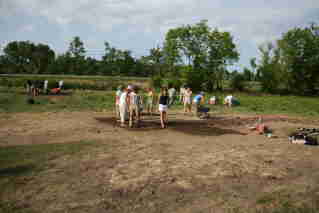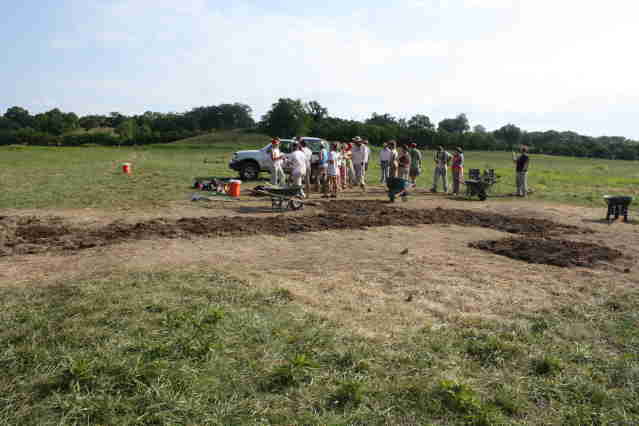
Field Projects: 2005-2011

| CASTALIAN SPRINGS ARCHAEOLOGICAL PROJECT Field Projects: 2005-2011
|
On June 1, we completed an orientation lecture on the MTSU campus.
The on-site report begins on June 2.
Our field class started up a little differently this year than usual. Back in March, Erik and I worked with Chet Walker to complete a gradiometer survey of the majority of the Castalian Springs site. In simplistic terms, the gradiometer records magnetic anomalies beneath the surface -- things like burned structures, fired clay hearths or fireplaces, and similar types of buried archaeological remains have a different magnetic signature than undisturbed soils. So, we started this year with a number of areas of potential interest. Among those was the area circled in yellow below -- what appeared to be several rectangular buildings with an adjacent courtyard or plaza. With that information in hand, we started early this morning laying out our baseline grid -- the flags are placed at 2 meter intervals (about 6 feet apart). Before 10:00 am, the students were using newly learned triangulation techniques to lay out square excavation units. Below, Brandon, Becca, and Wayne are using metric tapes to triangulate the location of the corners of their excavation unit. Before lunch, our crew of MTSU students had six excavation units marked out and the sod removal began. By early afternoon, our 2009 Field School Mascot had adopted us -- a mockingbird with a nearby nest landed on my truck to rest with a worm in her mouth. Her nest is a short hop away. Although we were still only working in the plow-disturbed upper portions of the soil today -- many small treasures began to emerge. Below is a small triangular arrowpoint -- a common artifact on this town site dating from around A.D. 1100-1300. Below -- a tiny bead made from a conch or whelk marine shell. The shell this bead was manufactured from probably came from the Gulf Coast of Florida hundreds of miles to the south. Tomorrow, we will continue working through the plowzone.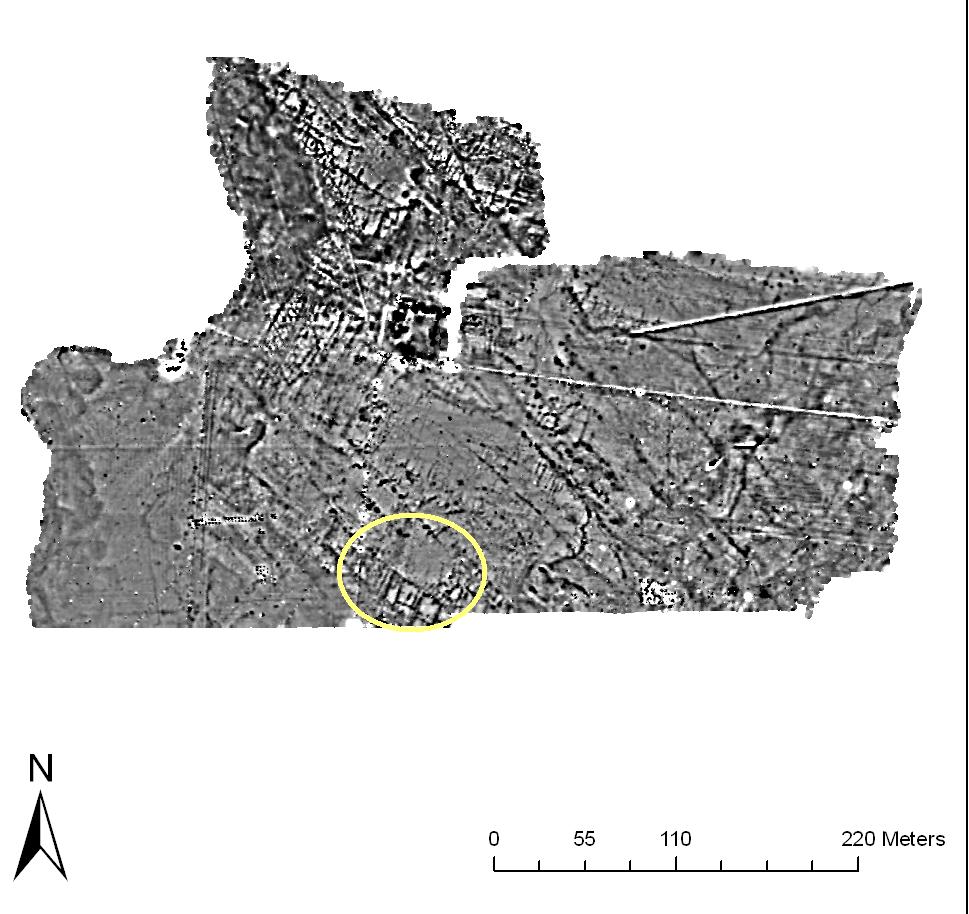


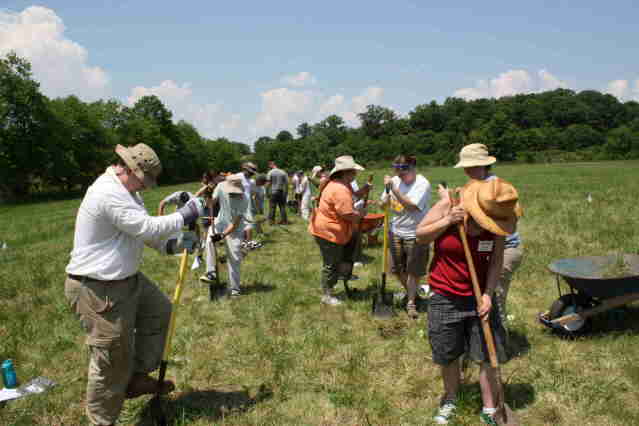
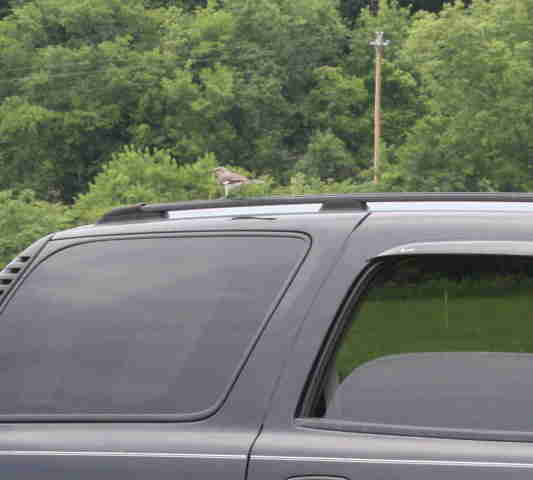
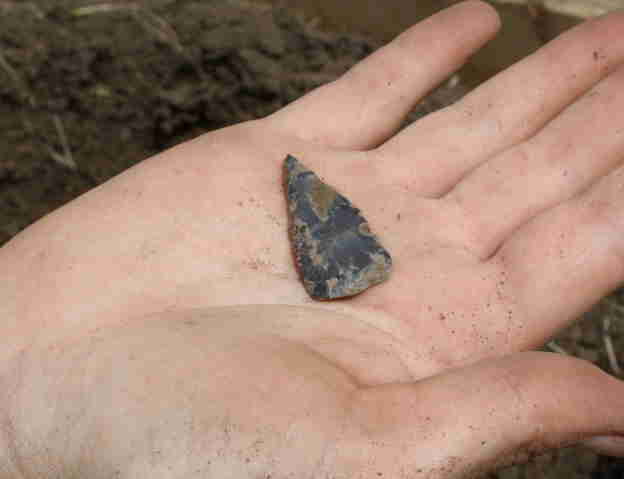
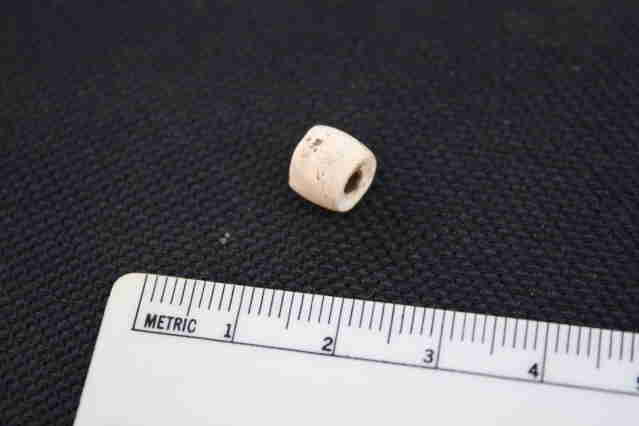
Today began a bit cloudy -- with the threat of showers and possible thunderstorms. Our excavation areas are protected with plastic each evening -- so the first task of the morning is to uncover. The upper 8 or 9 inches of soil on most of the site have been disturbed by decades of plowing -- the "context" of the artifacts has been largely destroyed. In many cases we would not spend much time on the plow-disturbed soil zones. Since this is a field training course, the plowzone in the first few units provides an excellent opportunity for practicing shovel-skimming skills -- as Amanda and Jason are doing here. Archaeological fieldwork also requires the keeping of multiple types of notes and forms documenting the daily discoveries. Michael makes some notes in the first page of his personal field book. The first few days of work also includes the slow growth of our "backdirt pile." The carefully screened soil is transported by wheelbarrow to a centralized location away from the excavation units -- although a bit of extra effort, this keeps the excavation area clear in case we need to expand an excavation unit. Jason practices his dumping skills. A brief downpour and the threat of rain moved us back to our field lab for the afternoon. Here, the students had the chance to wash up some of their finds from the plowzone and get a closer and cleaner look at what different kinds of artifacts look like. This time, the rain missed us in the afternoon.
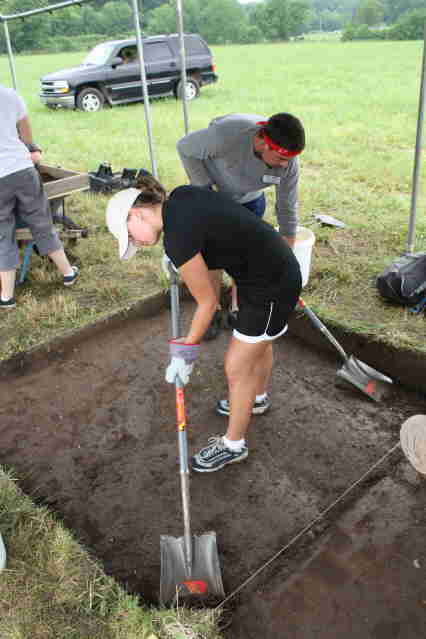

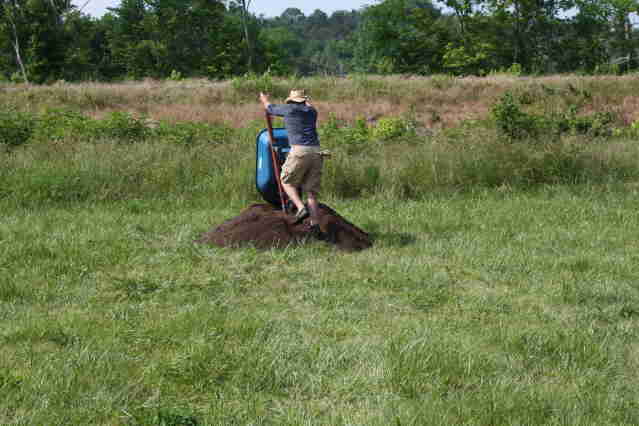
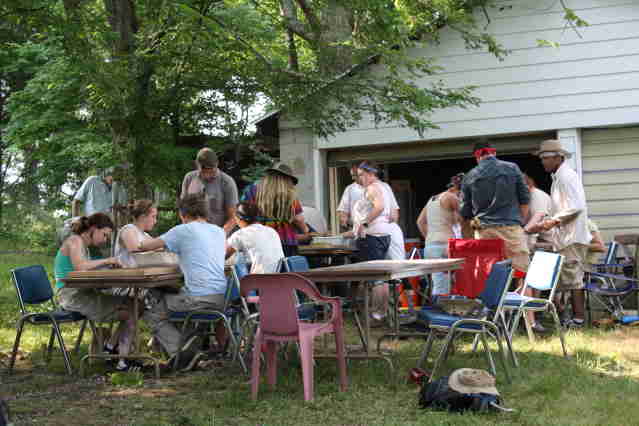
By this morning, most of the crews were nearing completion of their first excavation level. We dig in 10-centimeter "levels" (about 4 inches)
at a time -- this allows us to keep track of the 3-dimensional location of artifacts across the site. At the close of each level, the unit is cleaned up carefully and a photoboard is prepared showing the site number (40SU14), unit (N1060 E 810), level (Level 1) and date (06 04 09). Level 1 in these units is all plow disturbed -- this affects the quantity and types of artifacts that are preserved. For example, in these upper zones, very little animal bone is preserved -- fragments and the hard enamelled teeth are about all we find. Stone tools and fragments preserve well - but pottery is usually fragmented and heavily eroded. As we excavate deeper, the preservation of pottery, shells, and animal bones improves. Another part of closing out an excavation level is careful measurement of the actual depths. Students receive basic training on the use of a transit - a piece of surveying equipment used on many field projects. Here, Gage peers through the lens to take readings. Here, Emily answers questions from Jason, Amanda and Brady about the equipment. Over the next few days, each crew will be completing Level 2 (10-20 cm below surface) -- which should take us beneath the plow-disturbed soil.

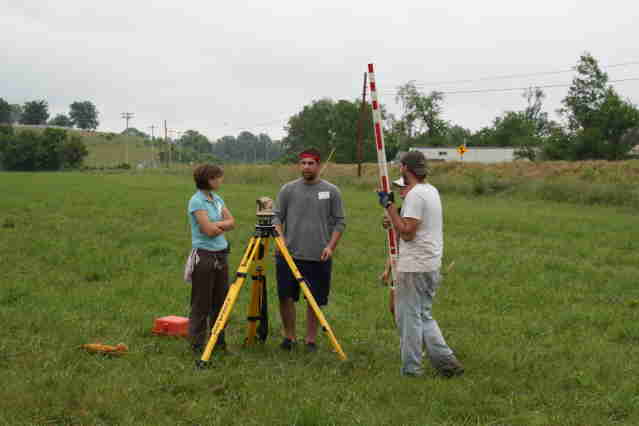

Our morning began as usual with uncovering the units and raising our shelters. Generally speaking, the weather has been fairly cooperative this summer -- for the most part, the days have not been too hot or too humid. And, despite the forecasts, we haven't had to close down very often for threatening weather. As the crews continue to excavate deeper in their units, we often shift from shovels to trowels, bamboo splints, and brushes for more fine-tuned excavation. Here, Jason, Amanda, and Brady explore some possible features in their excavation unit. "Features" -- as defined by archaeologists -- are disturbances to the soil created by human activity. Things like excavated pits (often later filled with garbage), trenches for wall foundations, and holes for posts all leave differences in soil color and texture to be discovered. Below, Kim, Tiffany S., and Ellen-Craig are using their trowels to look for evidence of features in their units. Outside of the fieldwork, we also get to enjoy an occasional beautifully clear night in the small community of Castalian Springs. Below is a shot of the full moon over the site. More tomorrow.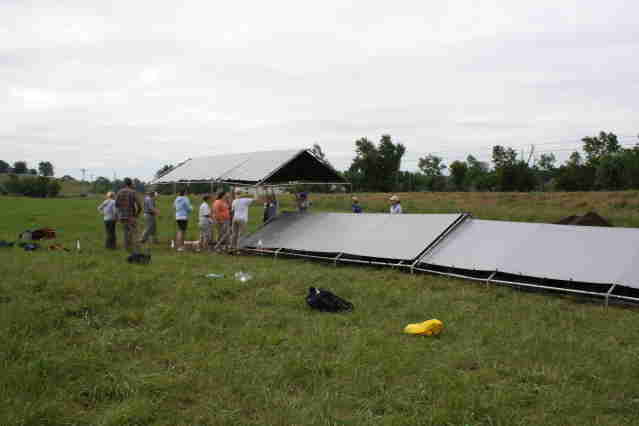


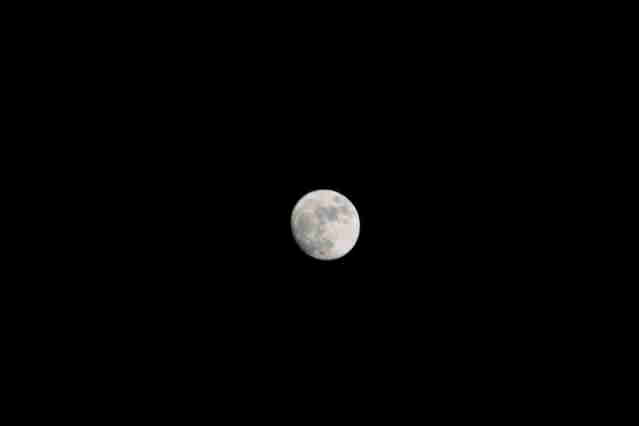
Today was the first of our four Saturday "Volunteer Days" -- where interested members of the public are able to join us for a few hours of archaeology at the site. This is also an opportunity for graduates of our field school program to come back and see what new things we've learned. Below, Lacey (a field school alum), and volunteers Evan and Ellis work with crew chief Brady. Below Erik Porth -- this year's Field Assistant and a 2007 and 2008 alum of the field school -- works with Kerri at the screen while Jennifer and Jesse (both field school alums) volunteer in the background. As Field Assistant, Erik's responsibilities are extensive -- he's responsible for everything from toilet paper at the field house to checking and approving student paperwork to taking his own comprehensive notes and drawings. Below, he works on a plan view of features in one of the units. As the days have passed, our crews have excavated to the bottom of the plow-disturbed materials. The distinct patterns of dark soils with artifacts and undisturbed surrounding soils become more distinct. The photo below shows two units at the base of level 2 -- the upper half to two-thirds of the units show darker organically enriched soils full of pottery sherds. The lower parts are lighter colored and have fewer artifacts. As we get below the plowzone, the artifacts are much better preserved and are documented more thoroughly. Below is a large portion of a box-turtle shell -- lying in place where a native of this town discarded it some 800-900 years ago. While they were almost certainly used for food, their shells were used as bowls, ceremonial rattles, and other functions. Our thanks to our volunteers who showed up today. Several field school alums -- Ryan McNutt and spouse Christy, Lacey Fleming and spouse Evan, Jennifer Clinton, and Jesse Tune. And several old and new volunteers -- Ellis Durham, Robert Beahm, and Connie Bucholz-Beahm.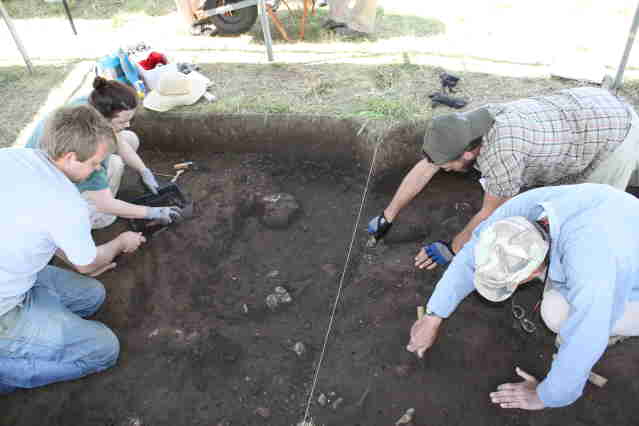
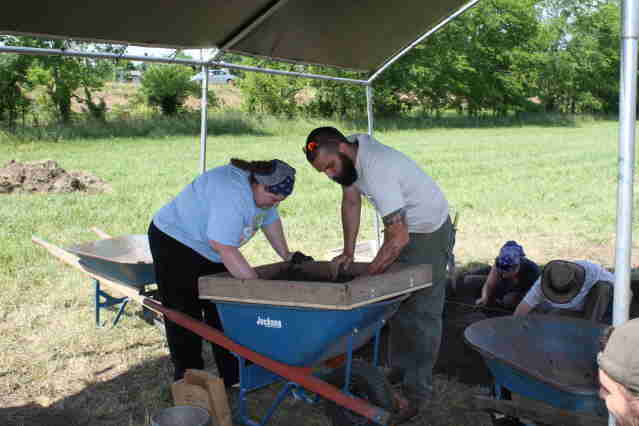


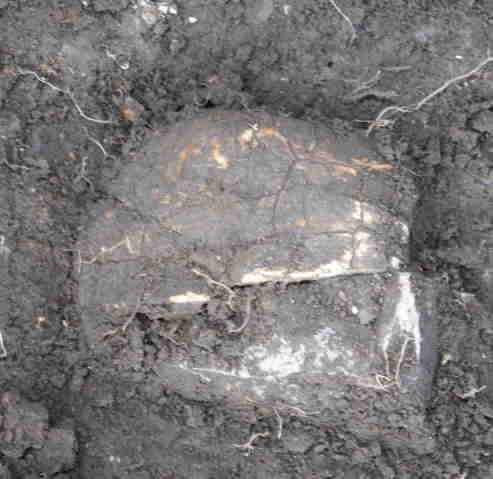
As part of our larger project, we are constructing a comprehensive Geographic Information System database of the site. This morning, Dr. Tom Nolan from MTSU's Geospatial Laboratory came out with Jolene Keen (an alum of our field school). Jolene is working on constructing a geo-referenced map of the site and our excavation data. Elsewhere, we continued excavations investigating several "features." Below, Brooke works on exposing a hearth (ceramic lined fireplace). Although disturbed by later prehistoric native construction, portions of this large fireplace are well preserved -- indicating the presence of a structure at this location.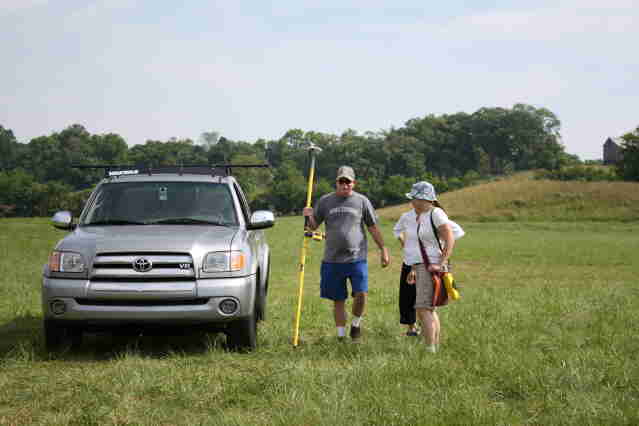
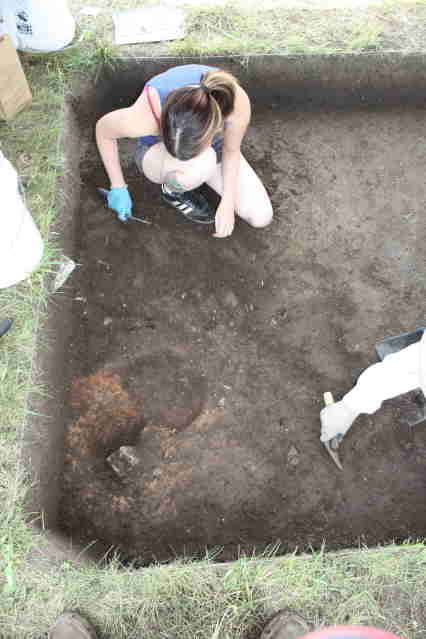

Very early this morning, Erik managed to FINALLY capture a photograph of our groundhog family that lives under one of the barns. These canny critters have evaded our photography efforts for three years now! Elsewhere on site, we continued investigating a number of features beneath the plow-disturbed zone -- including a number of ash-filled pits. Below is a photo of Feature 133 after removal of the ash -- the larger objects in the feature are large pieces of ceramic pots. The unburned nature of the artifacts in the ash tells us that these are ash dumps rather than hearths or fireplaces. These deposits represent baskets or pots of ash brought from nearby structures with a few other pieces of trash thrown in. Among the pottery artifacts recovered is another of our textile-impressed pans -- shown below is a fragment showing the impressions of a simple twined fabric.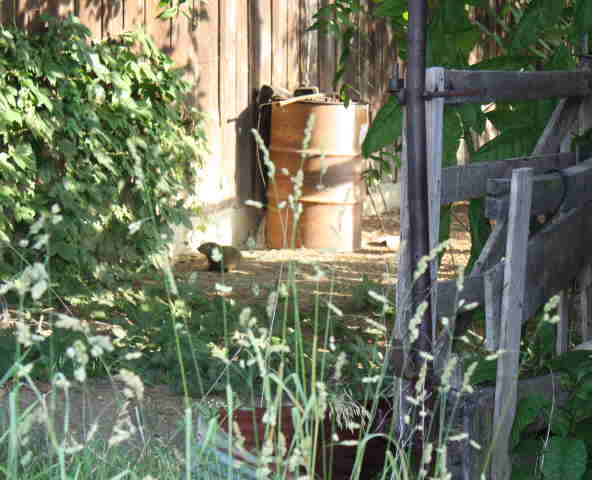
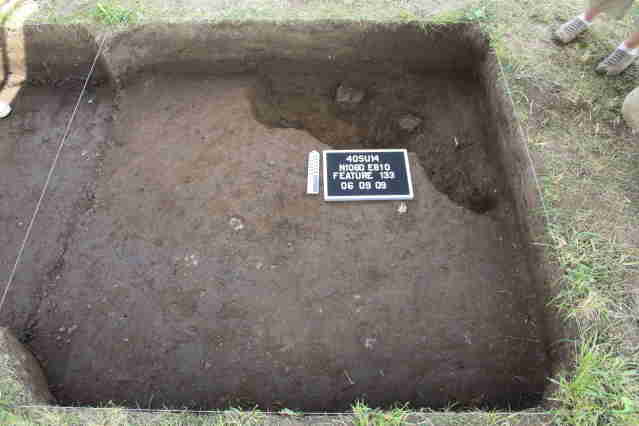

As our excavations continue, we are beneath the plowzone is virtually all of our excavation areas. Although we have not yet clearly defined any structures, we are clearly in areas where inhabitants of this ancient town were dumping their garbage (and ash from their fireplaces). Below, Colisha works on exposing a large deposit of ash and artifacts -- the lighter colored "stuff" to the left of her is an ash dump, and the lighter colored "stuff" below her is the beginning of other ash deposits. This area has begun to produce a number of large fragments of pottery -- many with very critical decorations that will allow us to date when this trash was created and thrown away. Below is a fragment of a jar with two incised arcade lines on it -- we know from other excavations that this should date to somewhere between A.D. 1200 and 1300. A number of handles from ceramic pots or jars have also been recovered from our excavations in this area. The one shown below should date somewhere in the early-mid 1200s. The handle shown below is relatively wide with a single node on the top. This one should late to the mid-late 1200s or early 1300s. Their discovery in close proximity suggests that this "ash dump" area was used for about a century or so by natives of this town -- probably living in houses nearby. We have a number of visitors and volunteers today. Below, Emily discusses our recent discoveries with Howie -- one of our long-term and faithful volunteers. We always appreciate his visits to the site -- he has volunteered on projects for decades around the world and brings many valuable insights to work with current students. Later in the day, we had a visit from Mike Moore -- State Archaeologist and Director of the Tennessee Division of Archaeology. Mike and I have worked together for many years on investigating the Mississippian peoples of the Nashville region. As the day closed down, we do our usual "closing up" process. Today, we forgot to secure some of our equipment -- Kim crawled under to complete that task. And finally, we brought the plastic over to protect the ancient remains of this town from the elements.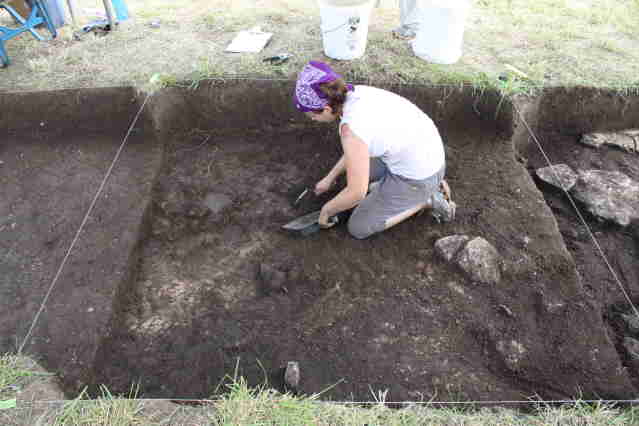




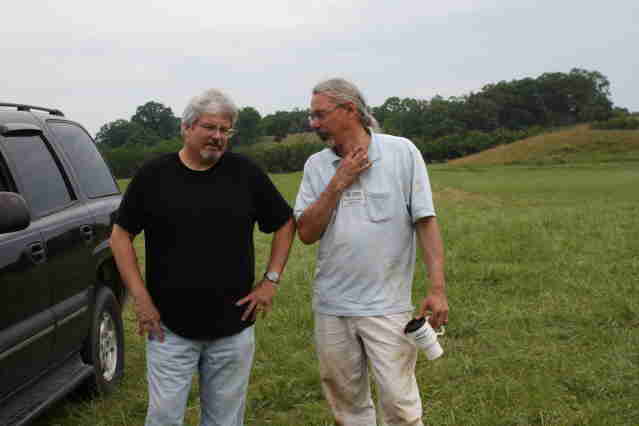
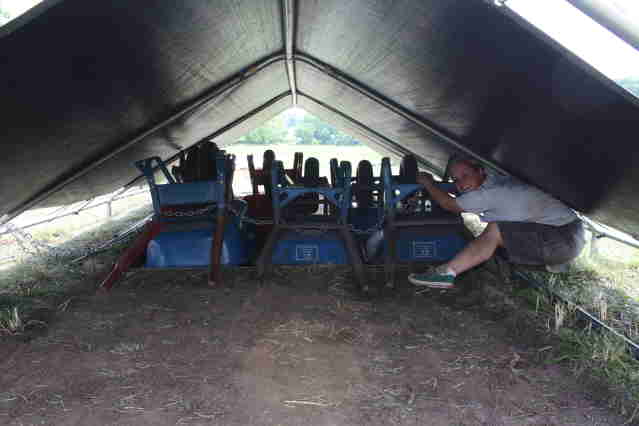
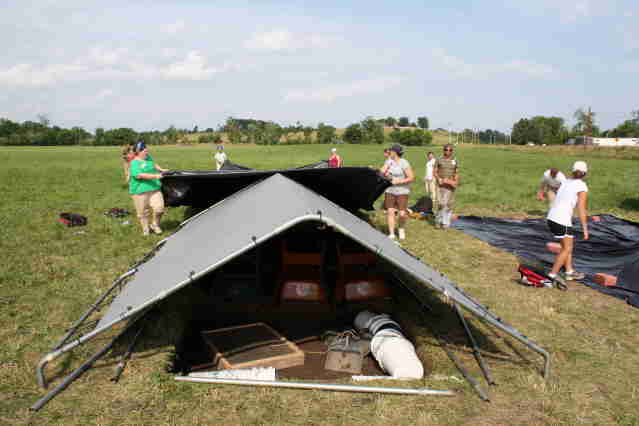
This morning, we started with a pleasant temperature and overcast sky -- but with threats of more severe weather later in the day. While we managed a couple of hours of fieldwork, the uncertainties of the unstable air mass in the area gave me pause. My first and foremost concerns are for the safety of students. Brief rainshowers and the bit of discomfort that comes from that is one thing -- thundershowers and storms are an entirely different matter. So, by mid morning, we closed
up our excavations and moved to our field lab. The storms and rain began a bit later -- and we were all safe. Although things cleared up by early afternoon, we decided to work on washing artifacts in the lab for the rest of the afternoon. Below, Erik supervises students on their washing activities. Labwork gives us a chance to take a break from the harder work of digging -- to see what we've found, and to have a bit of chatting and conversation. Below, Michael, Amanda, Colisha, Kim and Jerome share some funny stories. In our brief few days of excavation, we have already recovered tens of thousand of artifacts. Digging them up carefully and cautiously is only the beginning of the process. Washing, drying and sorting is an even longer part of our work. Then -- when we've finished that, the analysis and interpretation begins. The photo below shows the hundreds of artifacts from a single one of the bags of artifacts recovered thus far.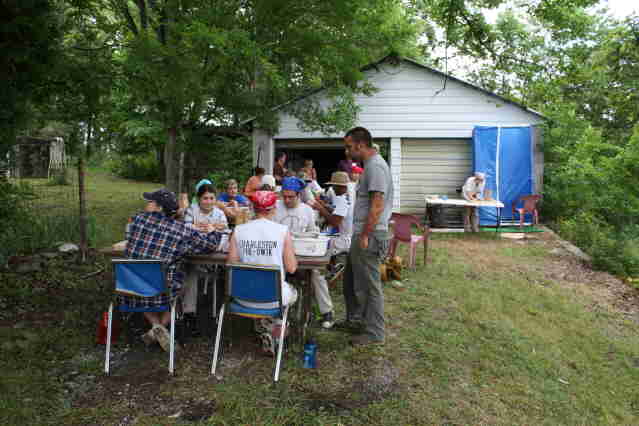
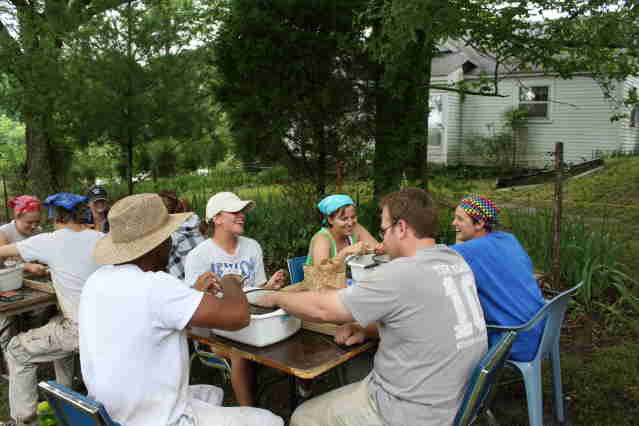
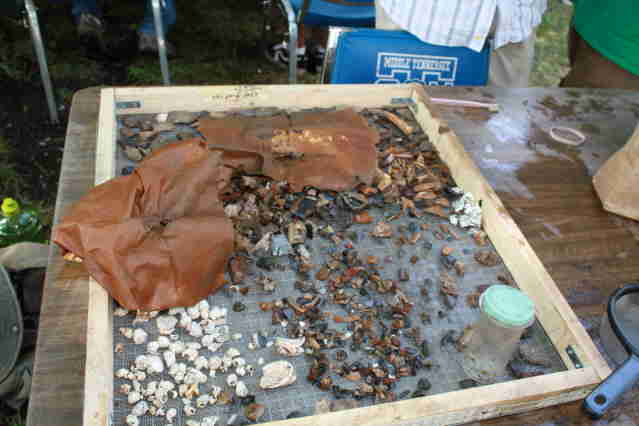
After a dazzling late evening thunderstorm, our plastic was a bit drenched -- but the excavation units underneath were largely dry and ready for excavation this morning. Early in morning, our friend John Garrott stopped by to check on our progress. We continue to more closely examine the dense deposit of ash (with a few artifacts mixed in here and there) in our westernmost units. Here Colisha and Nora clean up one of the ash units for a photograph. This particular area continues to produce a mix of broken pottery jars -- below is another handle from one of these jars. Another of our excavation units produced several fragments of a painted bottle -- although the design is barely visible in the photograph below, in person the sun-ray- circle around two concentric circles is still visible These fragments appear almost identical to two bottles excavated by William Edward Myer in 1891. His sketch for one of these bottles is illustrated below. We will try to piece together a few more fragments of this bottle in the lab -- hopefully enough can be reconstructed to tell if the central cross is also present on our bottle. Finally, later in the day we were visited by one of our friendly zebra swallowtails. Tomorrow, we will continue work with a few students and several volunteers for the second of our four "Volunteer Saturdays."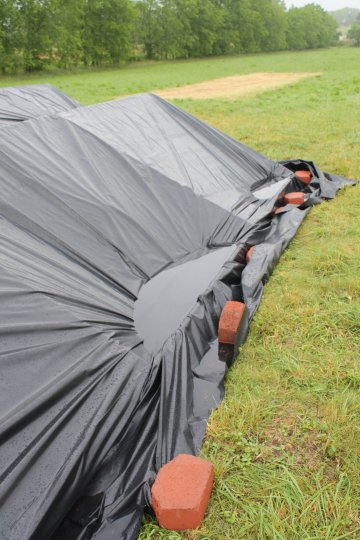
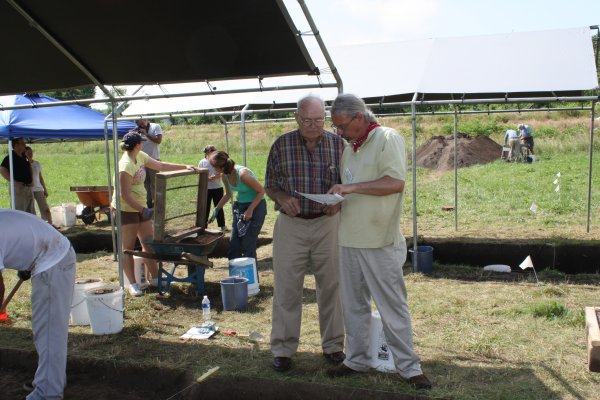
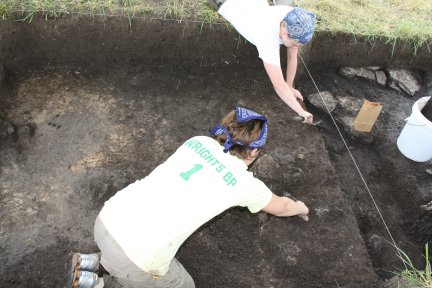

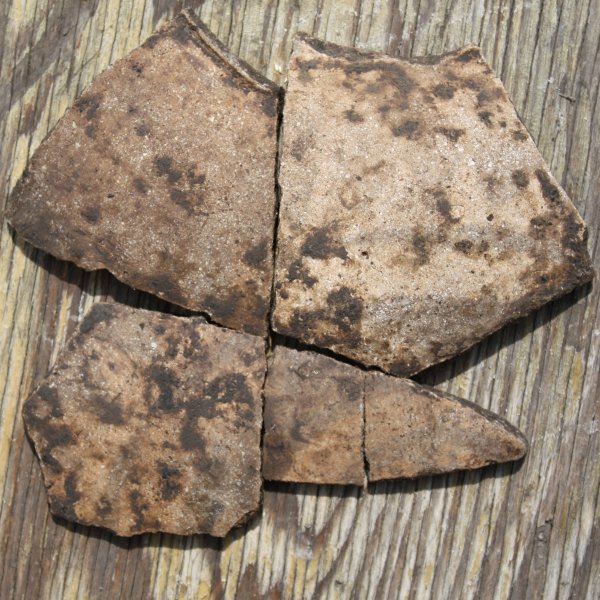
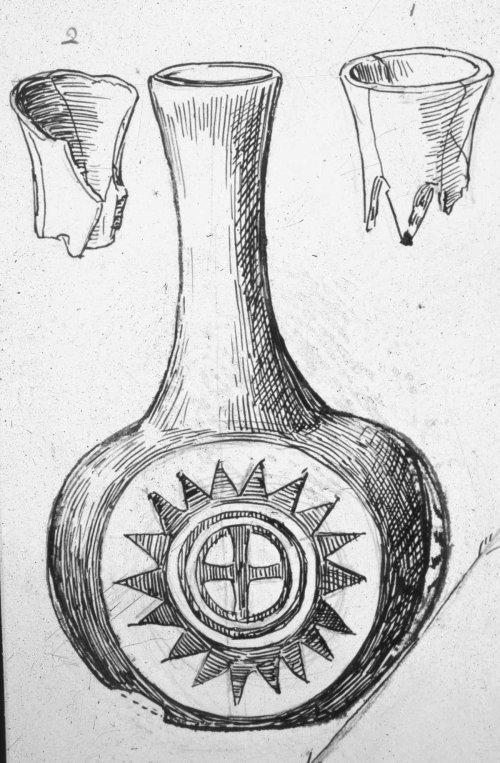
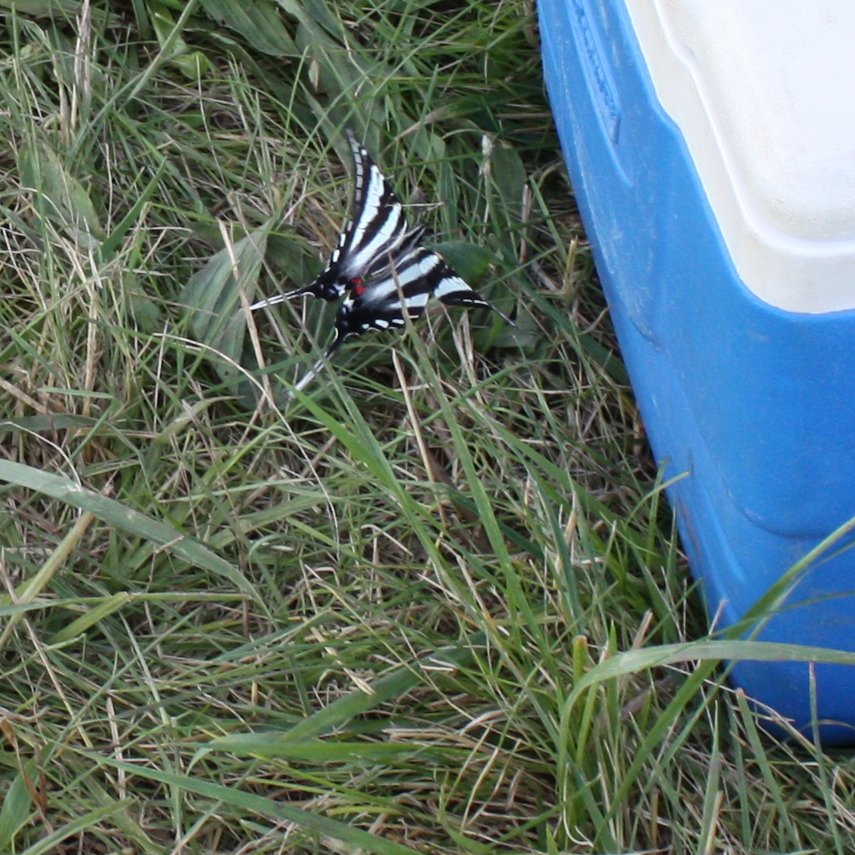
Today was the second of our Volunteer Saturdays -- where interested members of the public, family members, and alums have a chance to participate in the project. We had a tremendous turnout -- and everyone had a great time exploring some of the remains of this ancient Sumner County town. Several alums of the MTSU summer archaeological field school returned today to lend a hand and reminisce about the good ole days -- Brittany Brewer, Jennifer Clinton, Chris Hogan, Nikki Luttrell, Ryan McNutt, Jesse Tune. Several familiar volunteers from years past also showed up -- Howie Brainerd, Betty Callis, Ellis Durham, Heather and Tom Carden, and Ken Russell (Ellen-Craig's dad). We also had a few new volunteers this year -- the Sy family (Christine, Bernie, Noah and Benjamin), Mark Crawford, Forrest Lorrigan (Kerri's son), Lauren and Katie May, and Cindy Russell (Ellen-Craig's mom). Below, an enthusistic Noah assists me with excavations in one of our northern units. Here, Forrest regales Michael and Jason with his interpretations of the day's discoveries while Cindy works with daughter Ellen-Craig and Kerri in the background. The ash deposit has turned into an intriguingly squarish pattern
that may represent a small structure -- only further investigations next week will tell.
In the photo below, you should be able to see the ash patterns in the center. In the background, Howie, Erik and Jennifer discuss the digs while Lauren and Katie excavate in the midden. We're off for a brief day of laundry on Sunday before returning to our excavations early Monday morning.
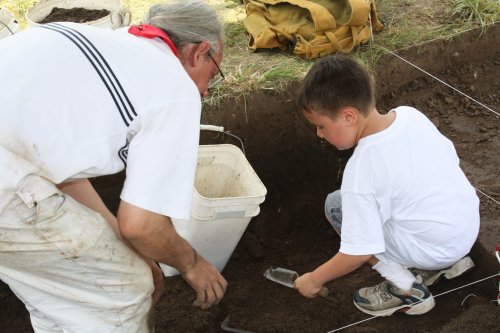
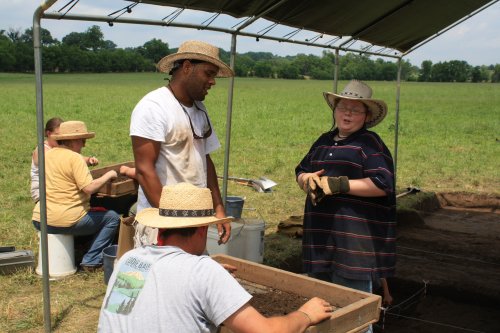
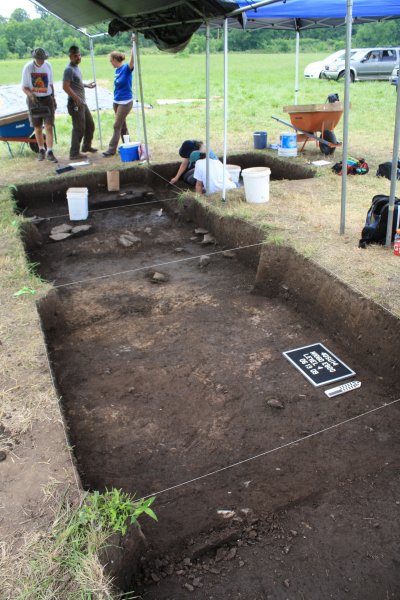
Work continued today with interesting results. We completed exposing the ash deposit today -- the light colors in the photo below are basketloads or pot-loads of ash dumped here by Native peoples 900 years ago. Since it seems to represent an ash-filled pit, we will be doing a cross-section of the pit.
Elsewhere, we completed excavation of the plowzone in two more units -- exposing the top of some promising differences in the soil. We are hoping to find some evidence of structures in this area -- postholes, trenches for walls, or other evidence. As always, we are constantly keeping notes and documentation. Here, Brooke takes measurements from the transit while Tiffany G. holds the rod. Our tiny back-dirt pile has grown over the last two weeks -- below Kerri returns from a run up the Hill. As we excavate, we find many interesting objects -- some are much older than the native town we are investigating today. Below is a beautifully flaked projectile point created some 4000 or more years ago. At the same time, we are also finding wonderful parts of the past of 900 years ago. In the bottom of the ash pit -- this giant portion of a pot with a handle showed up.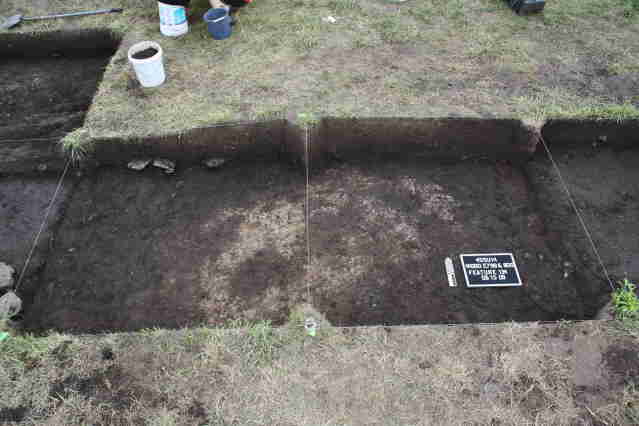
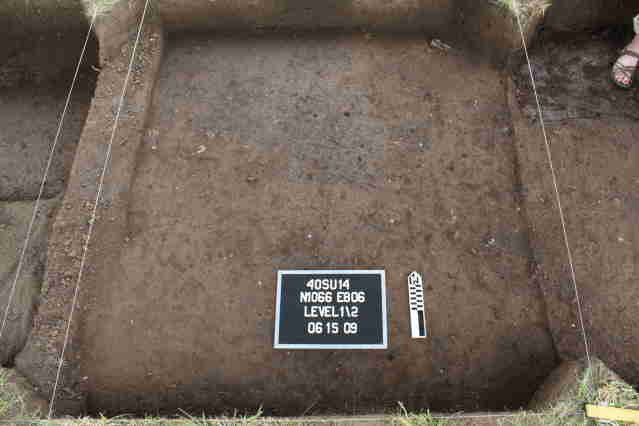
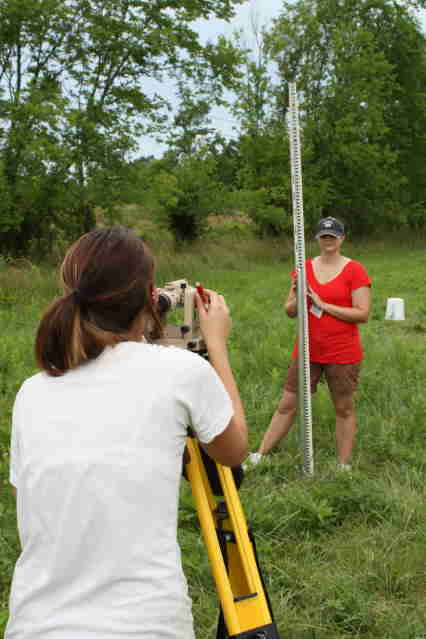
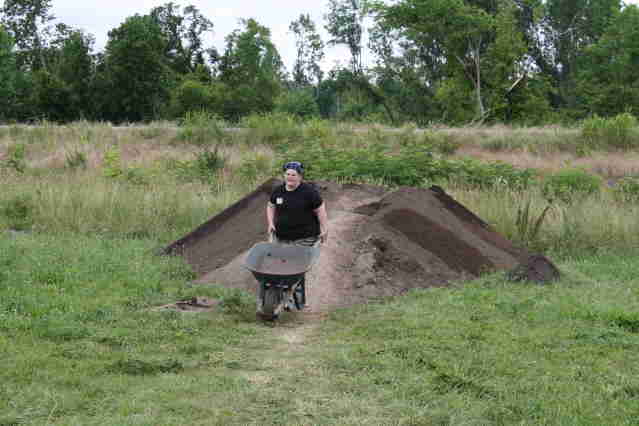
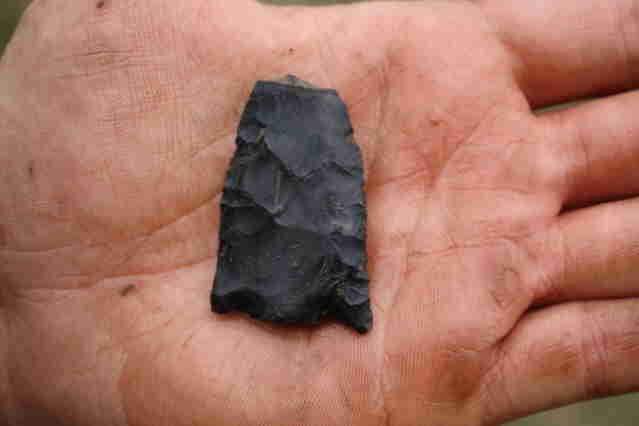

As Emily, Erik, and I arrived early this morning, the site was covered with fog and mist. Below is a shot of the big mound from across the field. We finished excavating about 1/4 of the big ash pit today -- thanks to our careful archaeological techniques, we can now interpret it as a large pit that was probably originally excavated for clay (for pots, house walls, and other things). It was then filled in fairly quickly with disposal from house fires. Here, Nora and Colisha are recording what we discovered today in the quarter section of the pit. And yes -- more handles and fragments of pots from this awesome feature. Elsewhere, we were visited again by one of our zebra swallowtail friends. Kim poses with one today. And a closeup on her hand... In the afternoon, we closed up early as storms approached. Our thanks to all of our friends who called and warned us of the approaching storm. We will resume our efforts to understand this town tomorrow morning.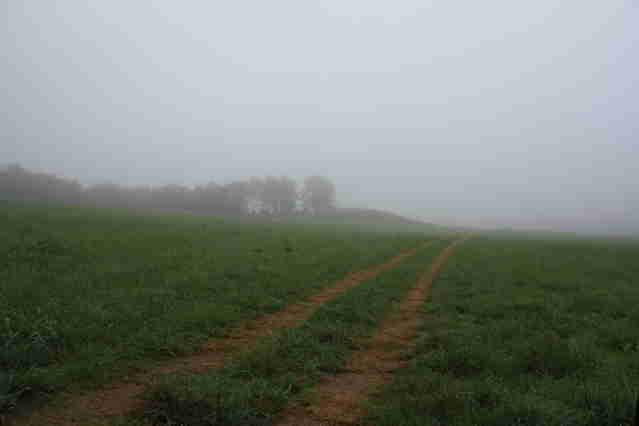
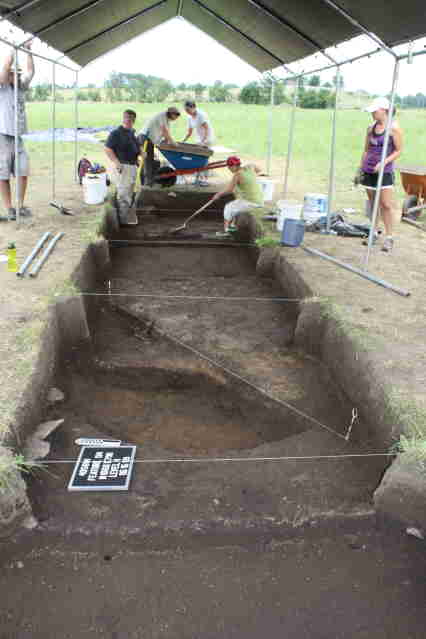
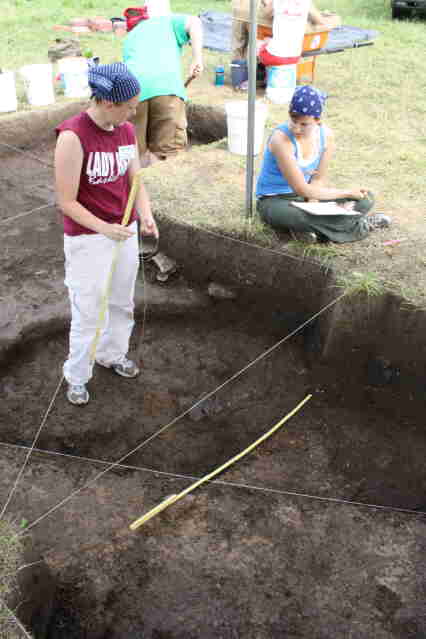
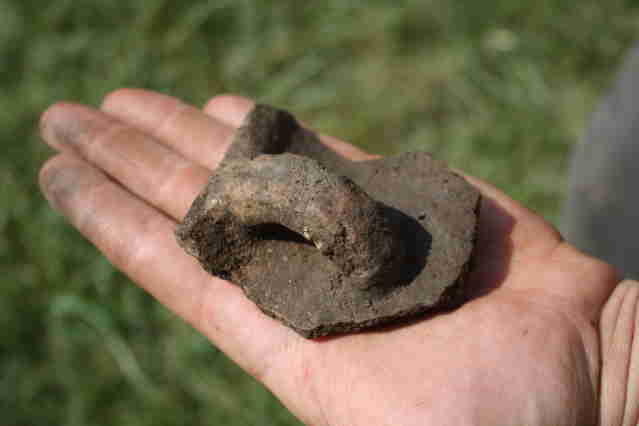
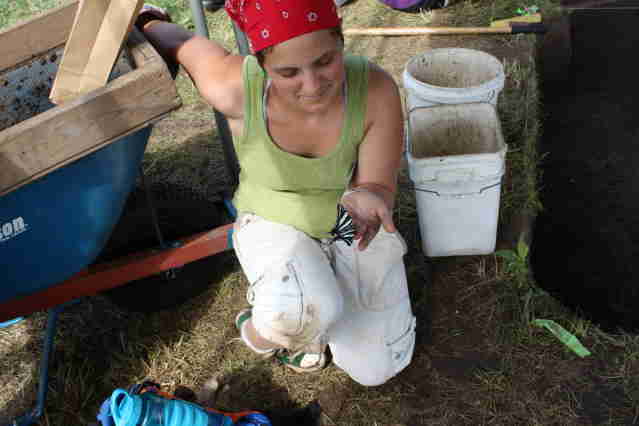
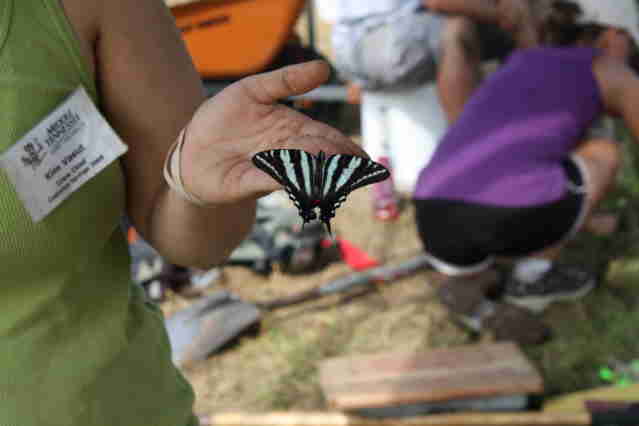
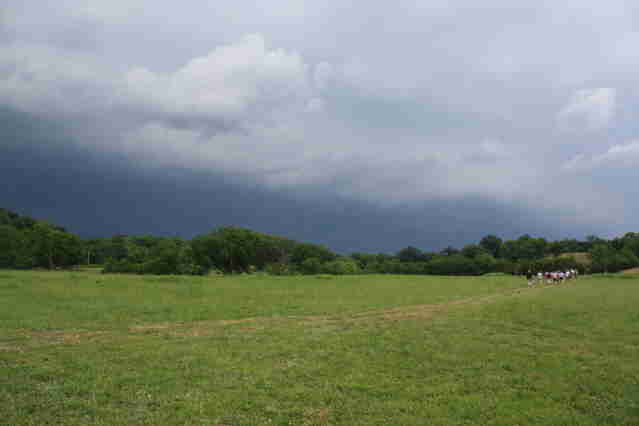
Today was the first truly "uncomfortable day" of our field school -- but not the last. It was extraordinarily humid at 7:00 am -- and while not too hot yet, it was more than hot enough. The next couple of days promise to be as humid and much hotter. Below, Gage chugs some water while Kerri shovels some dirt into the screen for Alethia. Elsewhere, we continue to dig deeper to look for new postholes, pits, or other features. Below, Wayne shovel skims the last level of their unit. Colisha, Nora, and Sara completed excavations of one half of the enormous ash-filled pit feature today. It is almost two meters (6 plus feet) in diameter. While it may have started as a pit to extract clay -- it was used later for a relatively short time for some special purposes. We will know more about this in the next couple of days as we complete the digs on this feature. I suppose the most important thing to say right now is that our goal as archaeologists is to understand not just what artifacts are in this feature -- but also to understand what it was used for. Our cautious, careful and well documented investigation will allow us -- perhaps -- the eventually understand how peoples almost 1000 years ago thought about this pit in the ground. Elsewhere, we also applied our careful archaeological examination to discover something really nifty. Near the fireplace or hearth discovered several days ago (yellow arrow below), we finally we able to identify what we thought might be a trench representing the wall of a structure (blue outline). As investigations continued today, we were able to confirm that trench without question. Below, Kim and Tiffany S. work on excavation of that feature. Below, Jerome continues to work on that wall trench -- the hearth is at lower left in the photo. The trench hopefully is now fairly obvious at the right of the photo. And finally -- in one of our other excavation units, we found the first fragment of a prehistoric tobacco pipe from the site. We are all hot, tired, sweaty, and exhausted this evening -- and looking forward to a couple of even warmer and more humid days in the future.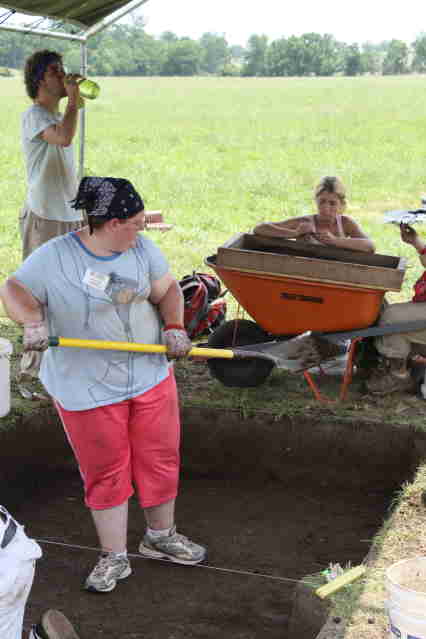
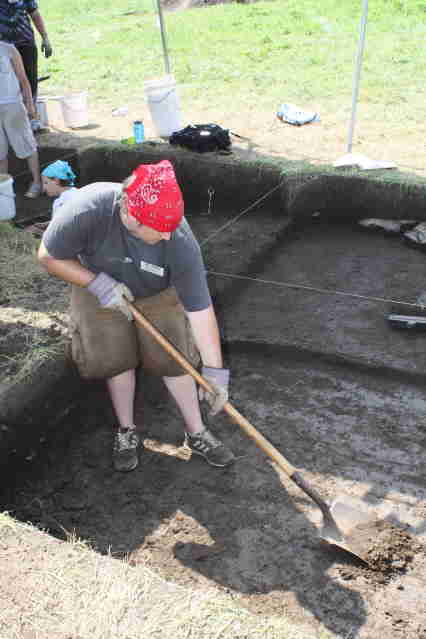
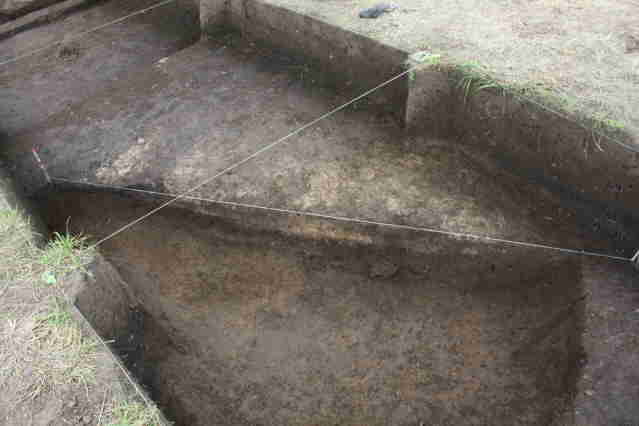

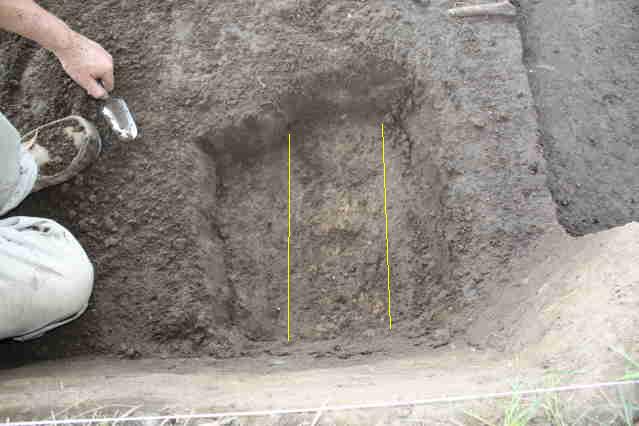

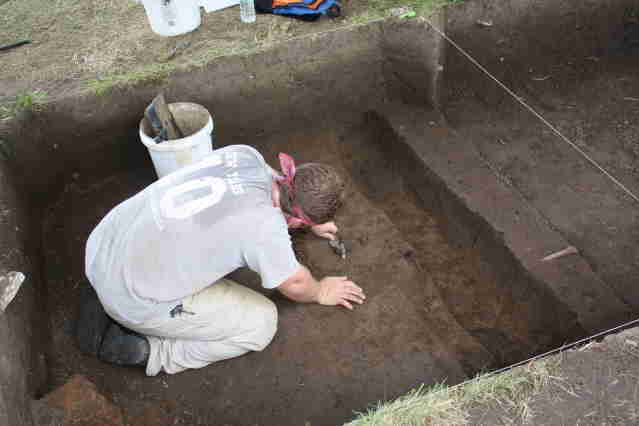

As the temperature continues to climb -- and the humidity keeps pace -- we continue our work on the site. Sprawled in uncomfortable positions for hours at a time, the students continue their enthusiasm for learning the "right way' to do archaeology -- and their excitement about discovering more about the people who lived here 1000 years ago. Below Tiffany S. cleans up the unit with the wall trench for a photograph. Below, the wall trench at left and the hearth at right are ready for a final photograph. Elsewhere, our pit feature continues to grow in size as we excavate further. This profile of part of the interior of the feature show several different layers -- representing different uses of the feature. The lighter colored zone on the top is almost pure ash. Below that is a darker colored zone containing broken potsherds, animal bone, and other artifacts. Below that is a lighter zone of silt that apparently accumulated while the feature was in use. Below, Sarah, Colisha, and Nora record information about this pit feature as they excavate. Elsewhere on site, our other crews continue to document their finds. Here, Gage and Ellen-Craig clean up their unit for photographs before excavating a possible wall trench and postholes. Since we now have discovered at least two structures -- and possibly four -- we will be expanding our excavations in the next couple of days to search for other walls. The weather oracles tell us that the next couple of days are going to -- well, let's be honest -- they are going to suck. High 90s and high humidity. Drink lots of water for us.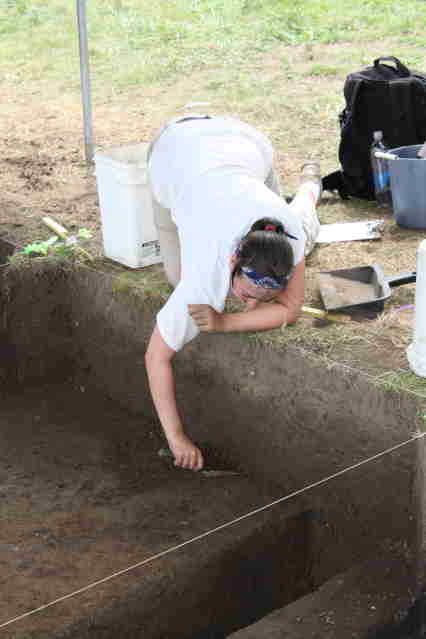
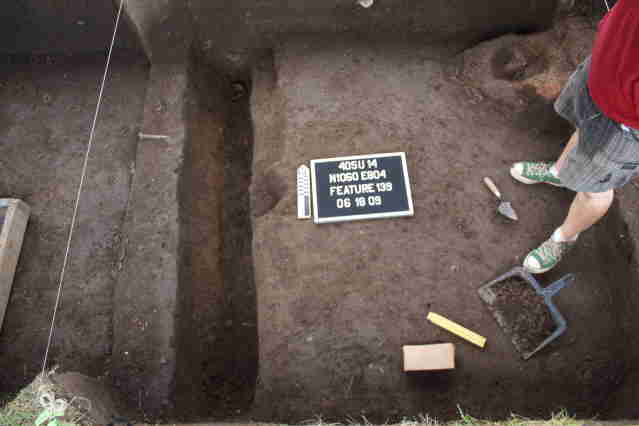
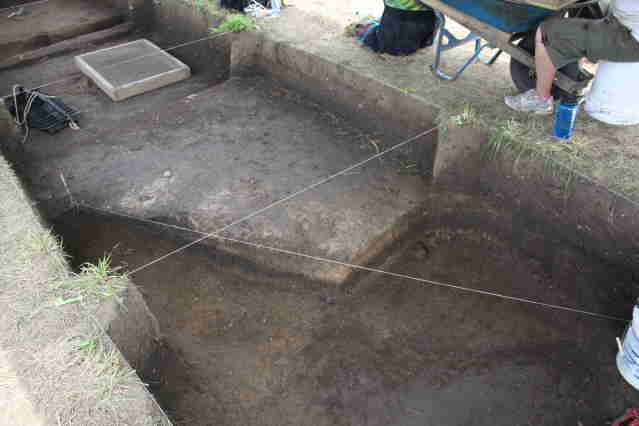

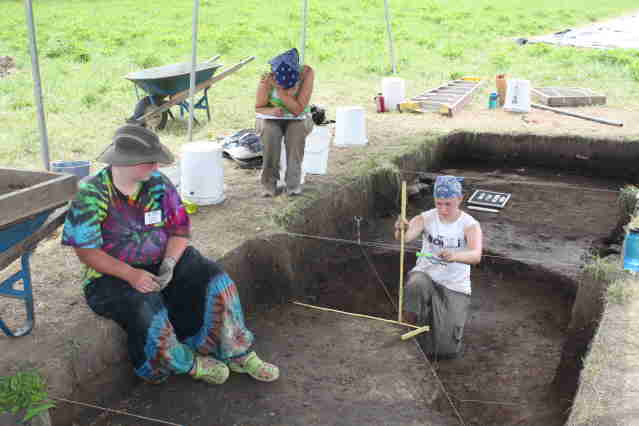
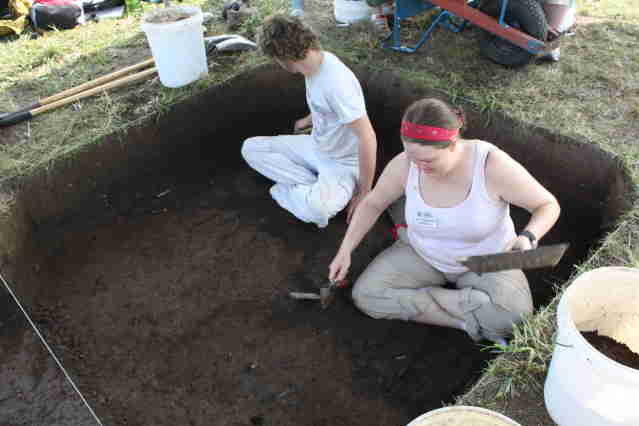
Unfortunately, the weather oracles were right on target for today -- hot and humid. We continue to work -- taking frequent breaks for water. Below, Becca and Wayne screen while Brandon shovels. Among their discoveries today was yet another large fragment of a fabric-impressed pan. We are opening some new excavation areas to try to find additional walls and corners of the ca. A.D. 1200 structure we discovered earlier this week. Here, Gage and Kerri lay out a new unit. Sarah continues excavation on Feature 134 -- the growing pit feature. If we find some posts around the periphery of this enormous pit, we may have to go back to our original guess. This might be a semi-subterranean structure -- where the floor was dug out below the surface. We should have a better handle on this in the next day or two. Elsewhere, our crews finished excavating some of the possible features described yesterday. The possible wall trench turned out to be a rodent burrow (Feature 140). Features 141 might be a post -- but it is small, shallow, and doesn't seem connected with anything else. So, we shall just have to record it as "possible post." Feature 142 also turned out to be somewhat unclear -- it might be a small prehistoric pit of some kind. But, it might not. We will have to look for more information to make some decisions on what these features represent. Having completed our excavations and documentation in three of our units -- we began the process of restoring them to their original appearance. Here, Erik dumps a load of dirt back into the hole while Brooke prepares for the "Backfill Dance. And here is a classic example of the BackFill Dance -- Brooke, Gage and Alethia pack the loose dirt back down. Tomorrow is the next to last of our "Volunteer Saturdays" -- and is projected to be the hottest of our days so far.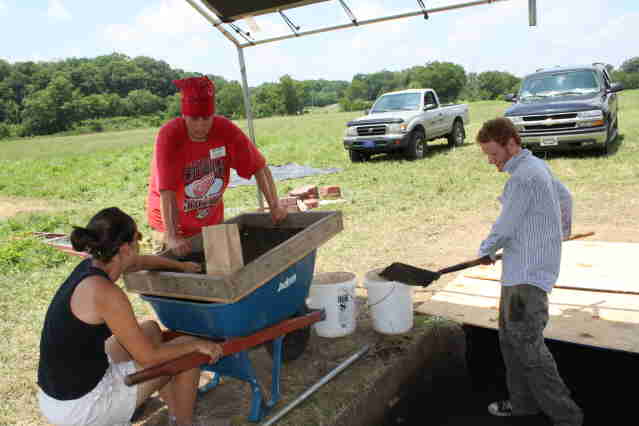
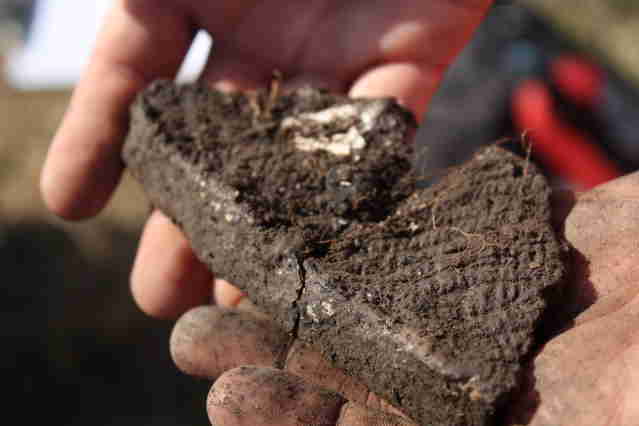

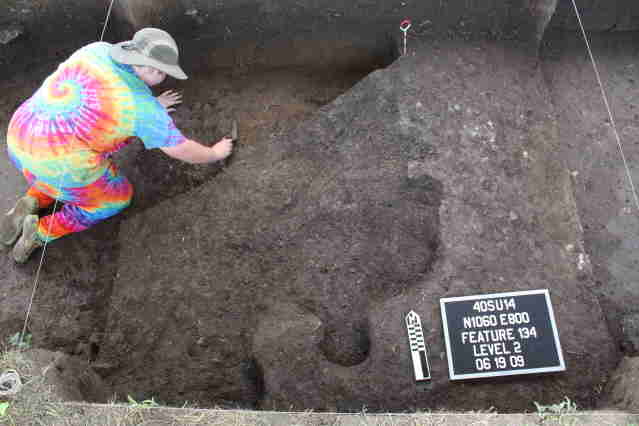

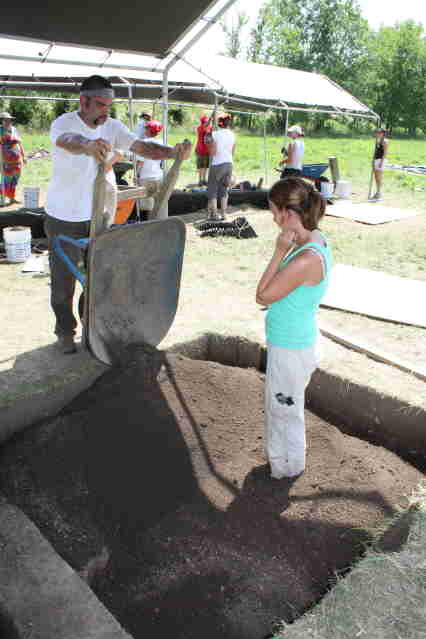
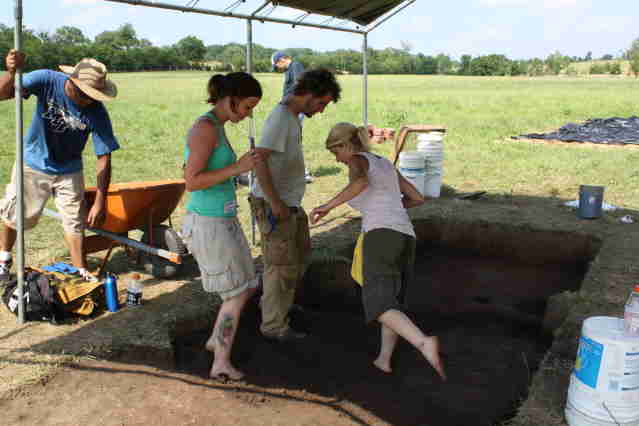
Today was the third of our Volunteer Saturdays. Despite the predictions of nearly 100 degree weather -- we had a tremendous turnout of volunteers and students today. On these days, our students work as supervisors for volunteers. We are also fortunate to have some of our field school alums show up -- they also help to supervise and entertain our volunteers. Our thanks to our returning field school alums for their help -- Brandy Dacus, Lacey Fleming, and Georgia Dennis. We also had some returning volunteers -- Evan Cole, Tom and Heather Carden, Bill Miller, Judy Shook, Forrest Lorigan, and Mark Crawford. And, we had a few new volunteers for the day -- Lee Wolfe (Brooke's significant other), Luyan Zhao (Brandon's significant other), Dom Baker (Alethia's significant other), Robert Snyder and Heather Bingess (Alethia's friends), and Christina Hodgins (Brady's significant other). Our thanks to everyone for some hard work on a very hard day.
Below, Michael works on one of our new units with Georgia and Judy. Here, Brandon (center) explains to Dom (left) and Alethia (right) the plans for finishing out his excavation unit. As they worked through the morning, they finished exavations in that unit and prepared it for a final photo. While nothing of major importance has yet turned up here -- the absence of major features and structures tells us as much about this ancient community as the presence. We seek to know where things are -- and where things AREN'T. The dark line directly to the right of the "arrow" in the photo is a rodent burrow. We're still not sure what the cluster of limestone rocks to south might have been. After finishing up the excavation, Brandon has to complete the drawing and description of the walls (sides) of his excavation area. Below, Brandon and Luyan measure to complete their drawings. Elsewhere, Brady and Christina completed our small unit -- trying to expose the corner of one of the wall trench structures. Below is a shot of their work. While it may not be clear in the previous photograph, we were able to clearly see the corner "in person." The photo below shows these two trenches forming a corner highlighted in yelllow. The "Big Pit" or possible structure continued to grow today -- another day or two on this to figure it out. Nearby, Forrest, Mark and Kerri worked on some newly discovered wall trenches and pits. Again, they may not be clearly visible in this photograph... But, we think we see several pits and the corner of another structure with two wall trenches -- highlighted below in yellow. Alas, we are discovering so many things and had so many volunteers -- I can't cover them all. Below in the foreground -- Tom
and Bill
work at the screen at left while Luyan, Robert and Heather work at right. The cast of thousands in the background. Below, Heather, Lee, and Robert work at the screen. And finally -- our nature lesson for the day. We discovered this caterpillar in our excavation unit. It seems to be a variegated Fritillary caterpillar -- for a common local butterfly. We are now taking a welcome day off on Sunday to sleep in, do our laundry, and get ready to start back up early Monday morning.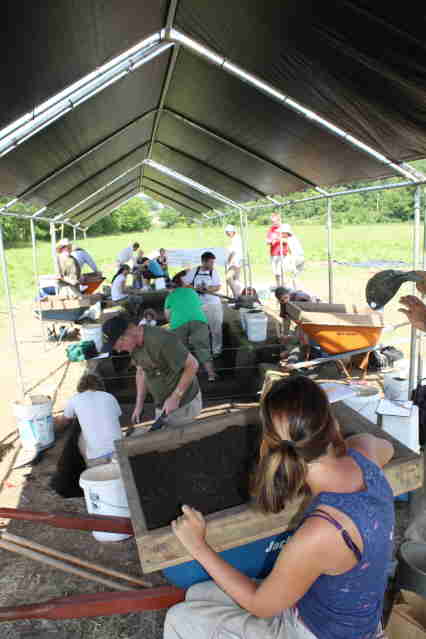
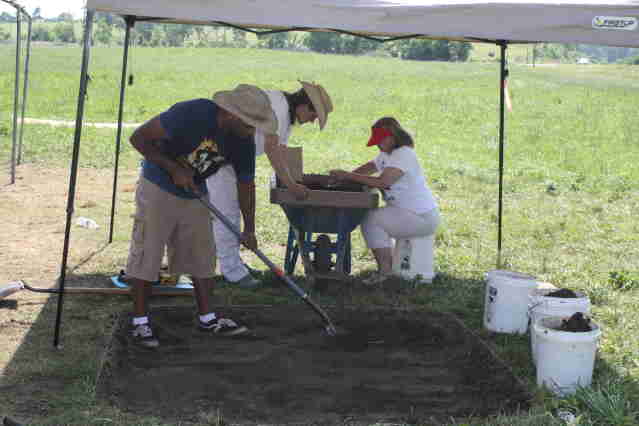
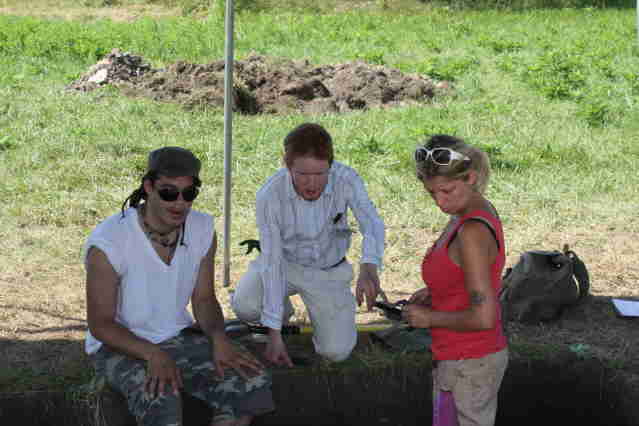
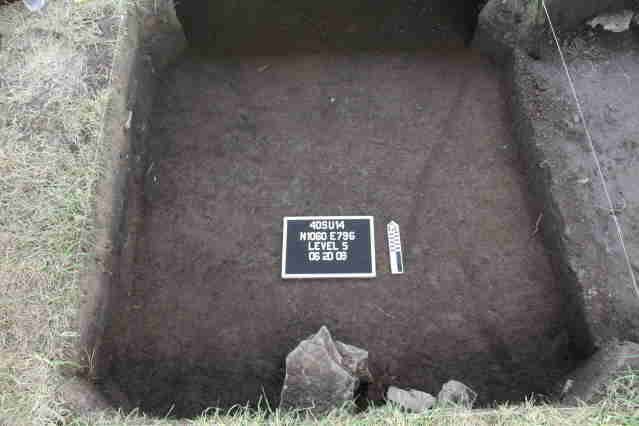
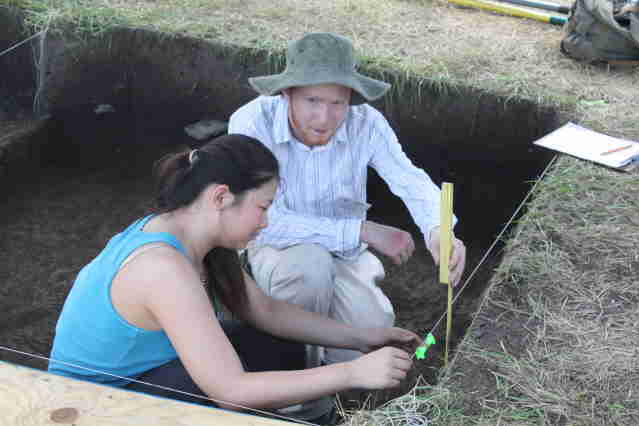
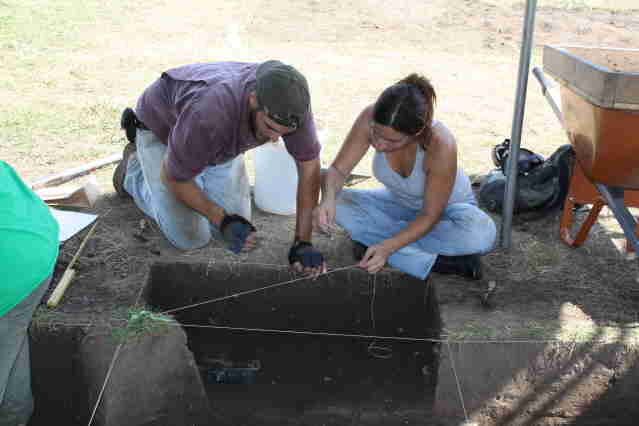
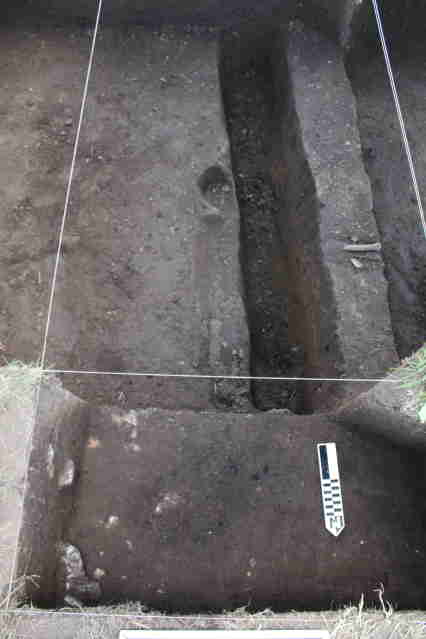
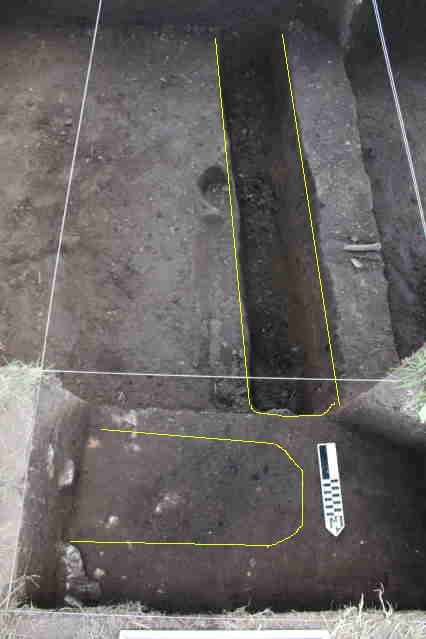
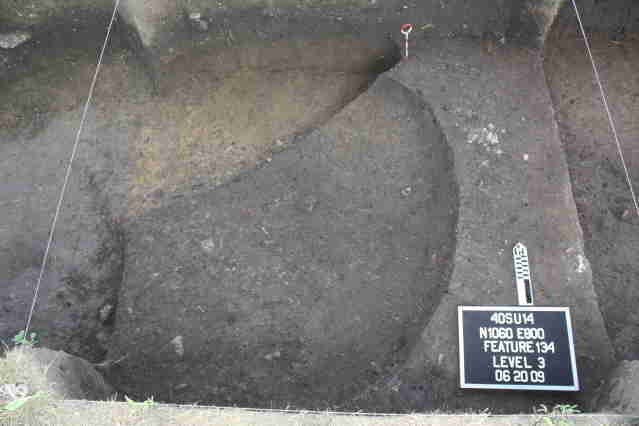
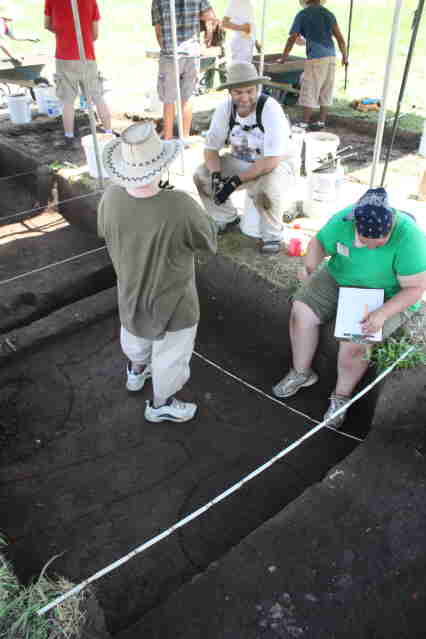
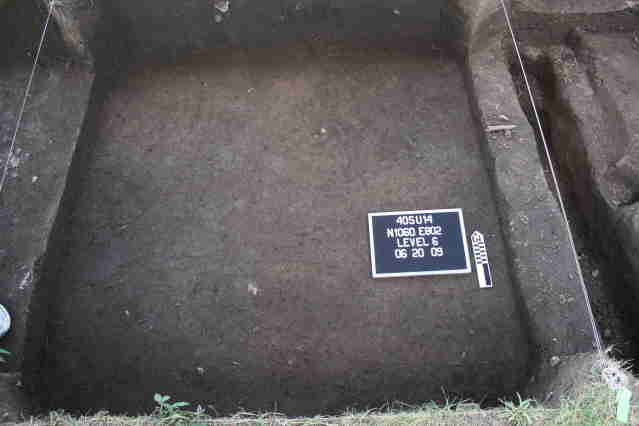

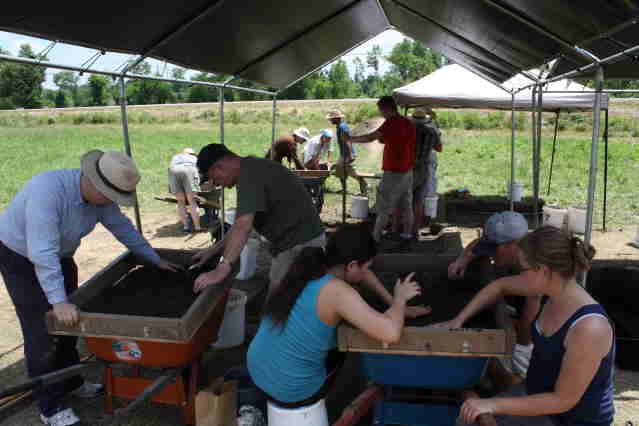

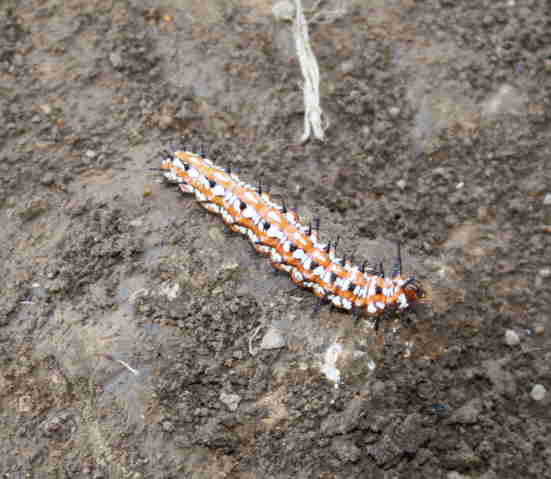
When most of us arose early this morning, it was quite apparent that today was not going to be memorable for the pleasant weather. Well before 8:00 am, several of us were already dripping sweat. By 7:30, Erik was mowing a new area -- we have a team of archaeological geophysicists arriving tomorrow morning to do some ground-penetrating radar survey on some selected areas of the site. Elsewhere, our crews were working diligently on documentation and excavation. Below, Brandon, Wayne, Heather and Becca complete profile drawings of their unit while Emily examines Brooke's paperwork in the background. As we continue to search for corners of the wall trench structures, interesting clusters of ancient garbage continue to show up. Below, one of the students exposes a large portion of a broken Native American pot -- discarded in a trash dump here some 800 years or so ago. This trash dump also included a complete deer bone awl or punch -- why this undamaged object was discarded by its owner currently remains a mystery to us. After removing the trash and overlying soil, we are able to see the continuation of the trench for the house wall. The photo below shows the continuation of the wall trench outlined in yellow -- the white outline is what appears to be the trash pit that contained the pottery and bone awl shown above. Careful examination of the two tells us that the pit was filled with trash first -- sometime later, the trench for the house wall was dug through it. Here, Gage works carefully to clean up one of the excavation units for a photograph. The uncomfortable position is necessary to prevent footprints in the freshly cut soil. The final product is a clean photograph below -- showing an excavated wall trench at the bottom, another probable wall trench outlined at top center, and three pits (one of the left and two overlapping pits on the right). By lunchtime, it was atrociously hot and humid -- below several of the students enjoy a brief lunchtime siesta. Given the bad working conditions and the predictions of similar heat all week, we moved to the lab to wash artifacts for the afternoon. The rest of the week promises to be a difficult one.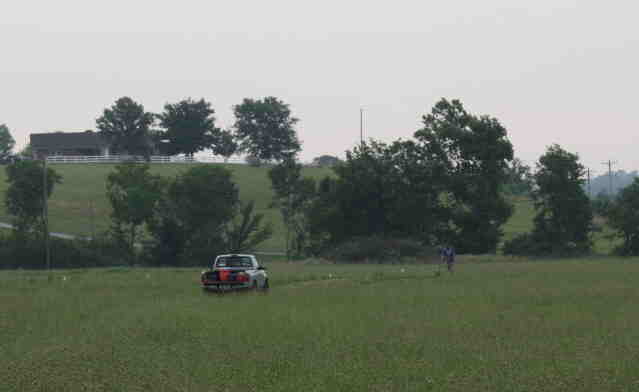
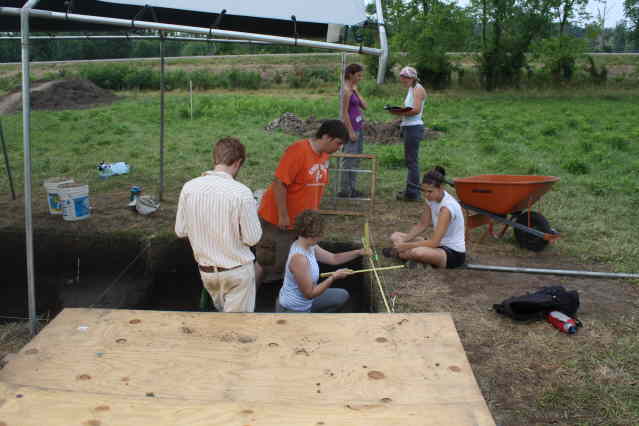

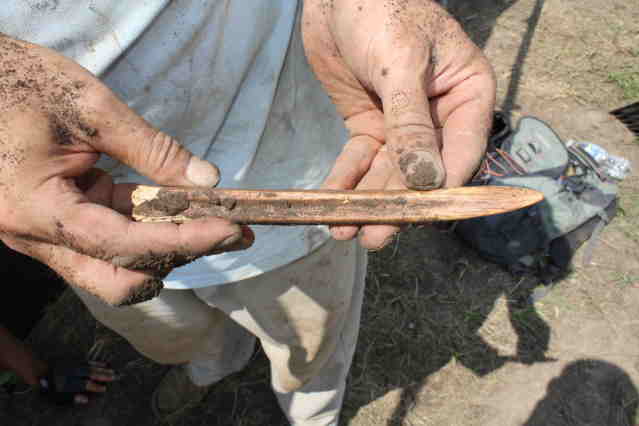
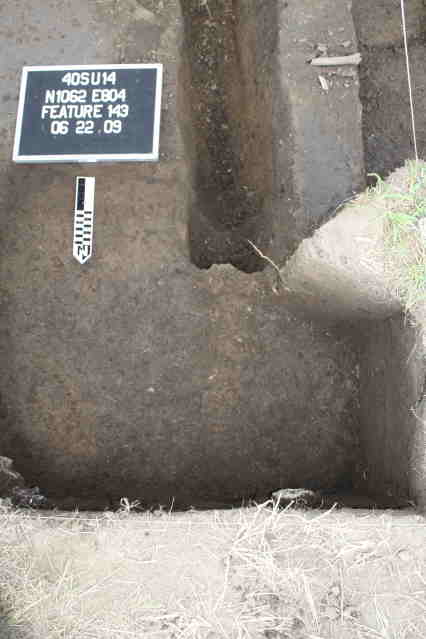
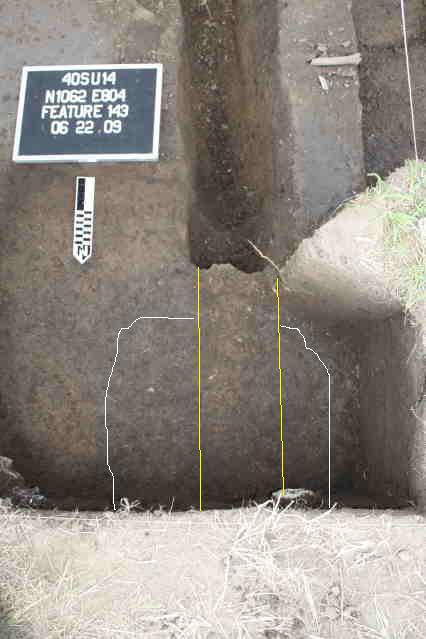
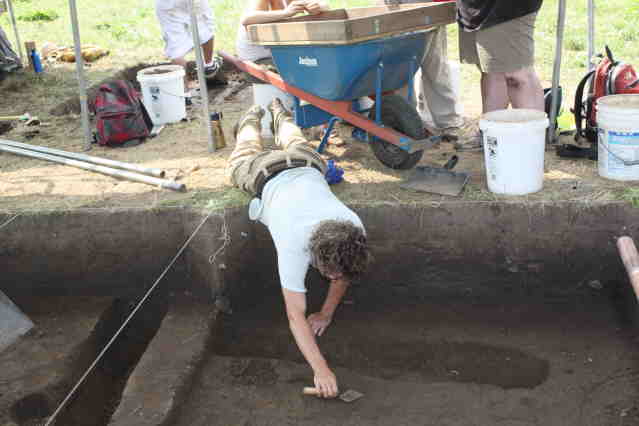
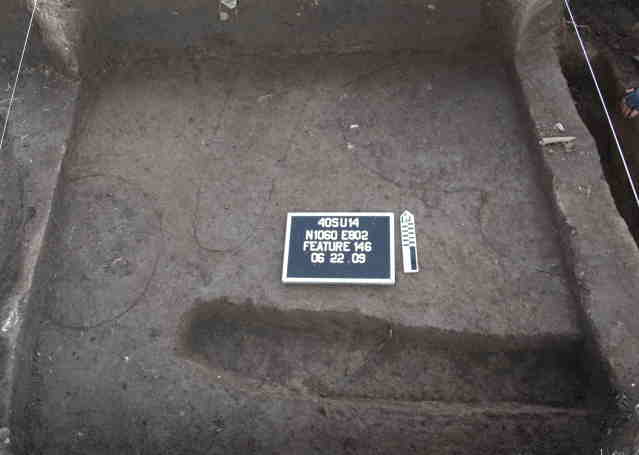

Despite dire predictions about heat, today actually turned out to be fairly pleasant (for late June in Tennessee). Upper 80s, humidity not too bad, partly cloudy, and a nice constant breeze. We continued to excavate a number of features today -- possible pits, postholes, and trenches. The feature labeled 146 below is the south wall of a structure used about A.D. 1200-1300. The feature labeled 145 is part of a large pit -- only part of it is excavated here. The dark line running down the middle of the pit is an ancient crayfish burrow. Mid-morning, Chet Walker and Jennie Strum (Archaeo-Geophysical Associates LLC) arrived loaded down with specialized equipment. Both of our gradiometer surveys (2006 with Dr. Gerald Schroedl and 2009 with Chet Walker) showed a large circular anomaly that might be a large public building. Then again, it might just be a coincidental circular signature resulting by chance from surrounding features. 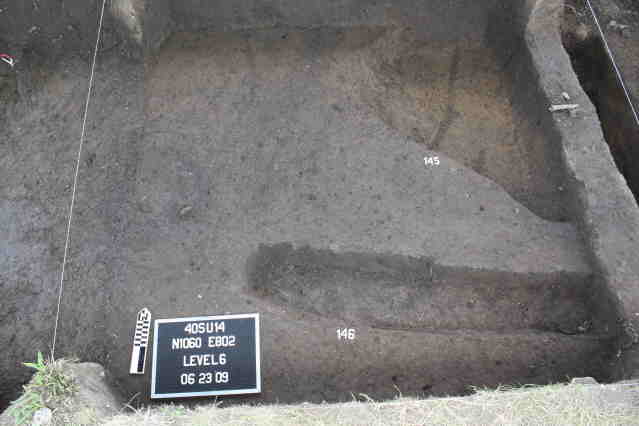
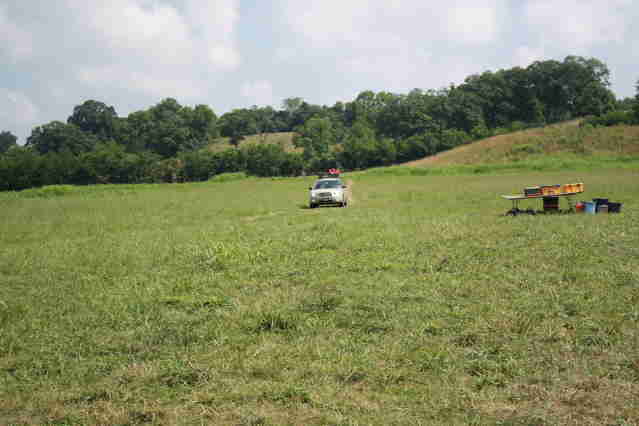
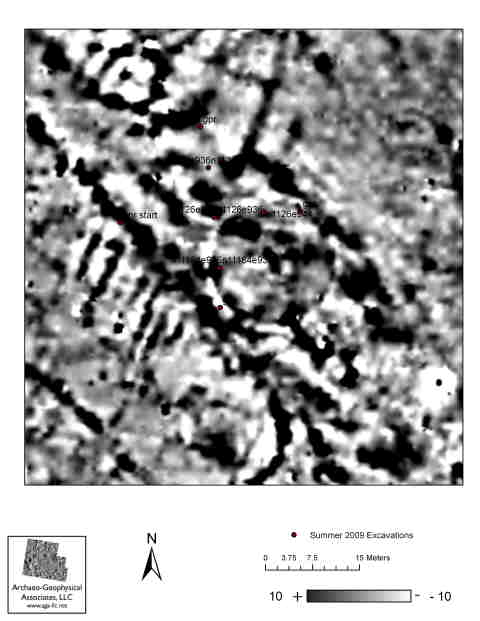
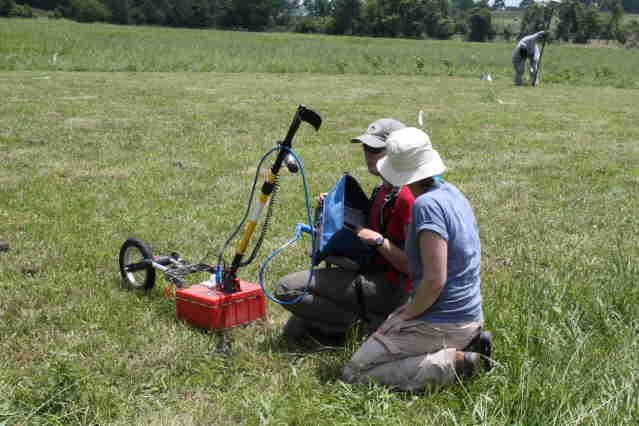
Elsehwere, the crews have worked their way through the plowzone in three new units -- these units were placed in an effort to locate the corners for the three wall trench structures we have located. In one of these units, a corner and floor of a fourth structure (!) showed up just beneath the plowzone. The floor deposits immediately yielded fragments of burned corn cobs...
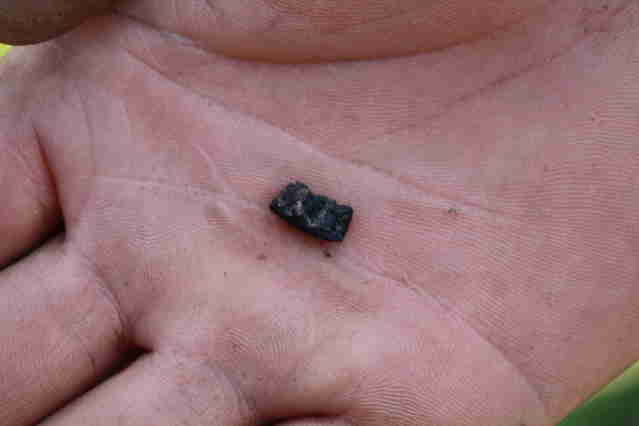
And well preserved pieces of burned corn stalks...
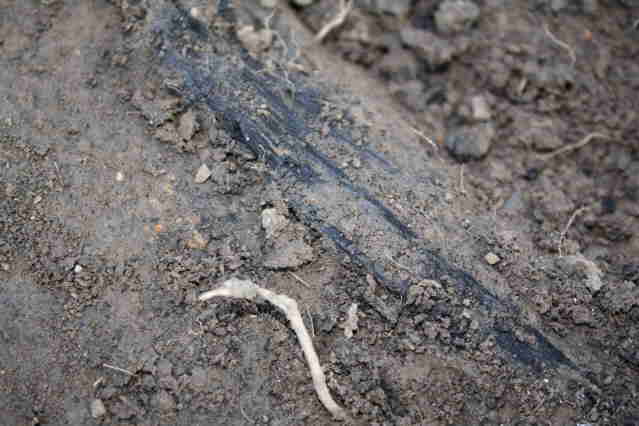
While Brandy and Jennie work on the GPR survey of the 20x20 meter block (about 60 x 60 feet), Chet records our unit corners and several features with his GPS -- so we can confidently link individual features in our units with the magnetometer data.
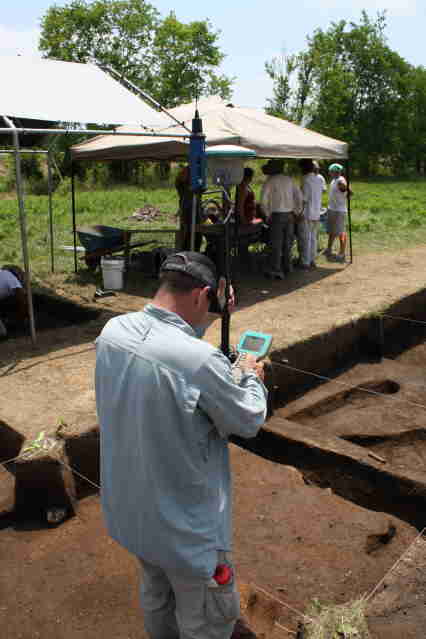
We worked much of the morning on cleaning up several of our excavation units for photography. From atop a high ladder, the patterns of features are often much clearer than on the ground. Below, the easternmost set of units is shown (looking south) -- several excavated features can be seen, along with several dark stains that represent unexcavated features.

The image below is the same -- with several features highlighted. The two long trenches highlighted in yellow are the south and west walls of one large wall trench structure. Several postholes and small pits are also highlighted in yellow. The blue lines show part of the west wall of another structure. The unfinished excavation unit to the south will hopefully catch a corner of that building -- and the unit to the north will perhaps catch another corner. At the left highlighted in red is a probable trench representing the west wall of yet another structure. We are hoping the excavation units to the south will catch at least one corner of that structure.

The overlapping structures represent use of this part of the site over several decades -- with structures being torn down and new ones being built. Although we can't be precise without additional analysis, these three overlapping structures probably represent at least 60-90 years of occupation.
The results of today's GPR survey will be examined tonight.
Today again was not quite as bad heat and humidity wise as predicted -- although it certainly didn't remind anyone of the Arctic circle.
The GPR data from the 20x20 m block looked very promising when we examined it last evening. While Chet traveled to Georgia to work on another job, Jennie stayed to help Brandy complete a larger GPR block -- 60x60 m. Erik was up at 6:45 am mowing the large block -- a task that took 6 hours with a pushmower. Jennie and Brandy were able to begin the survey as Erik continued mowing. We continued working on investigation of features today -- the photo below shows the three possible posts or pits at the bottom of the large pit. Each of these appears to represent the very bottom of a posthole. The crews continue to work away -- the photograph below shows Feature 147 -- a medium-sized pit -- after excavation. Here, we will work next on the other wall trench. The units continue to produce some interesting fragments of ancient garbage. Below, Kim uses wooden tools to clean around a fragment of animal bone. Below, one of the students shows one of the spectacular finds of the day -- a large portion of a stone "celt" or axe retrieved from one of the trash deposits. We have also atracted a new mascot -- the young bird below has been hanging out with us for several days. He/she is learning to fly -- and enjoys the many worms in our backdirt pile. Looks like perhaps a young mockingbird. Tonight, we'll look over the new GPR data and make some decisions about where to excavate.
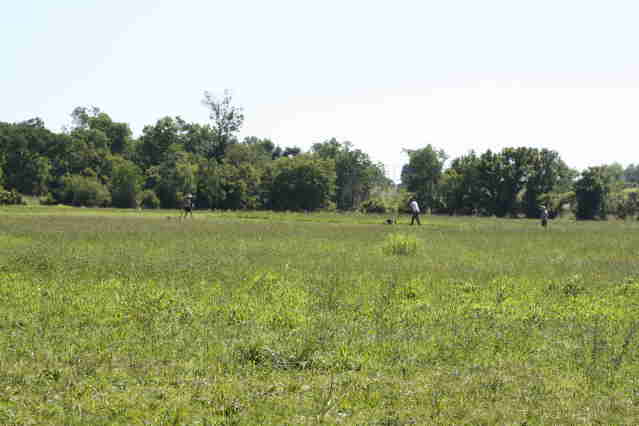
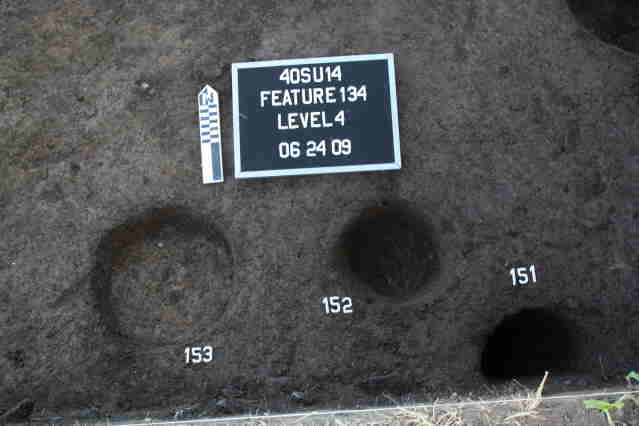
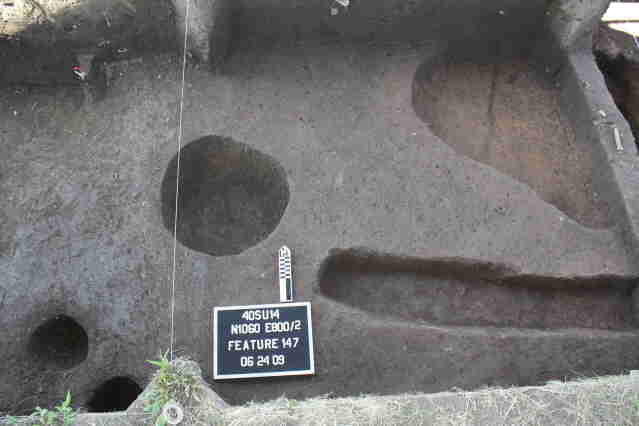
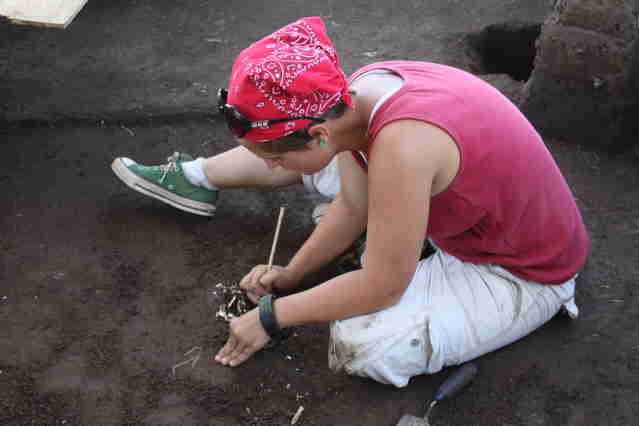
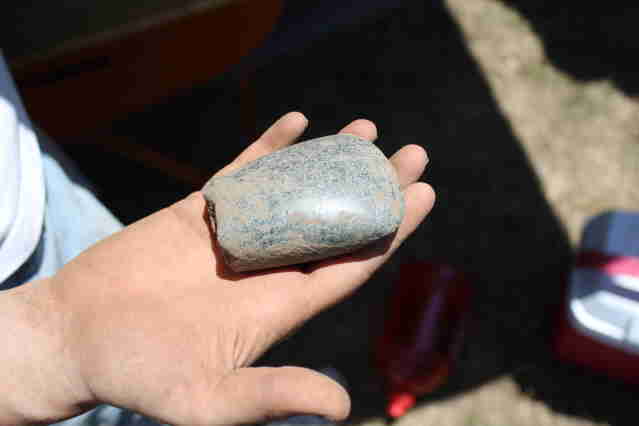
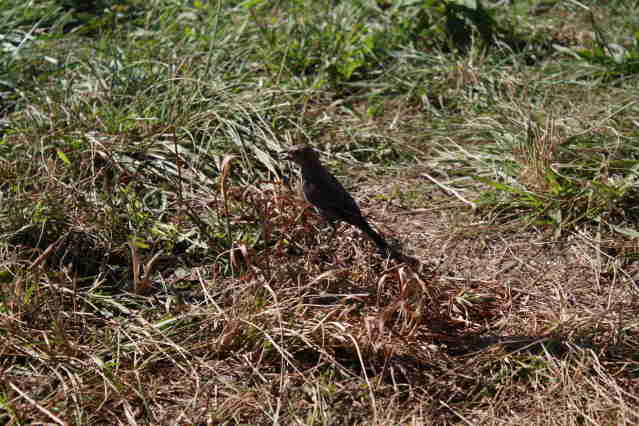
Today started out early with temperatures already close to 80 and the humidity not far behind. When you are able to grab a handful of air and squeeze water out of it at 6:00, the message is fairly clear! We continued to work on excavation of features throughout the morning. Below, the 144 at the upper center of the photo is just to the left of a faint dark stain representing what we think will be the west wall of one of our structures. It should match up with the previously excavated portion of the south wall at bottom center. Here, Ellen-Craig and Gage begin their efforts to examine this faintly visible feature with trowels. Our fourth structure is now fairly clearly visible -- the dark stain in the lower right quadrant of the unit is the floor fill. Below (same photo), what appears to be two wall trenches intersecting at a corner with the floor fill inside is highlighted. Examination of the east wall of the excavation unit shows the top of this ancient floor -- the dark band in the unit wall is burned wood along with corn cobs and stalks. After lunch, it was simply too hot and humid to work in the field. So, we took a break in the shade up the hill to wash up artifacts. A number of interesting small objects were washed up this afternoon -- including a small fragment of sheet copper. The fragment is too small to let us determine what type of artifact it originally came from -- it might have been part of a copper-plated earspool or similar type of item. We know these objects were used here. A fragment of a negative painted pottery vessel also appeared during the washing today -- this is probably from a plate and would be another example of Angel Negative Painted. Below is a beautifully preserved example of a bead made from a bird bone -- although I can't identify the species, it looks to be a fairly large bird. Dr. Tanya Peres, our project zooarchaeologist, will perhaps have some insights in the lab. Finally, this remarkable arrow point is a whitish color -- and quite transluscent when held up to the light. The stone does not appear to be local -- so this is probably a trade item. Tomorrow promises to be yet another miserably hot and humid day.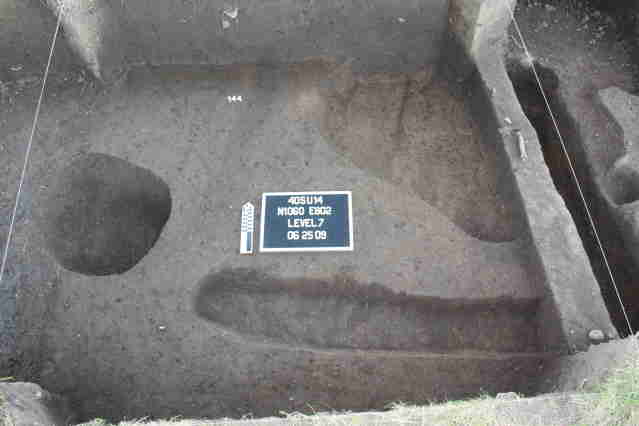
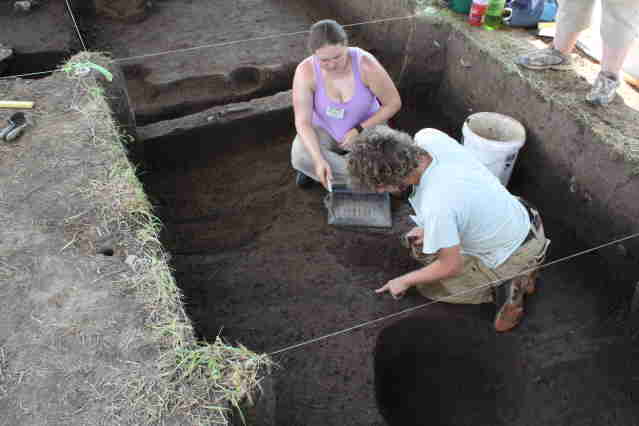
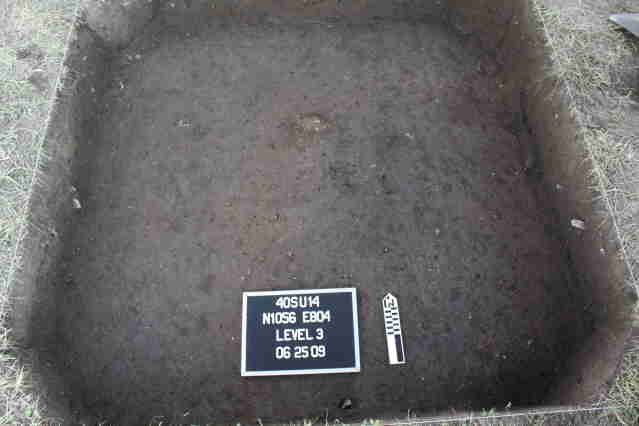

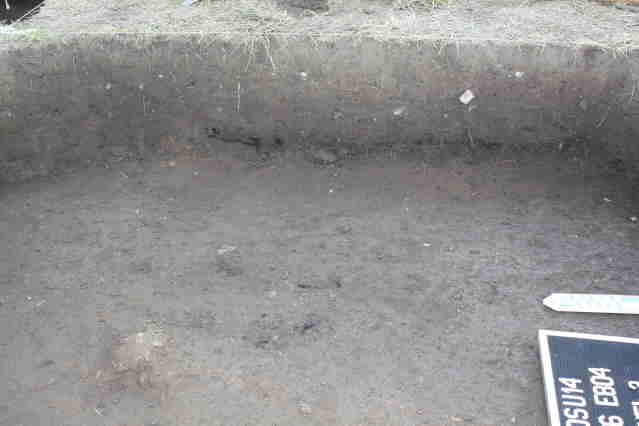
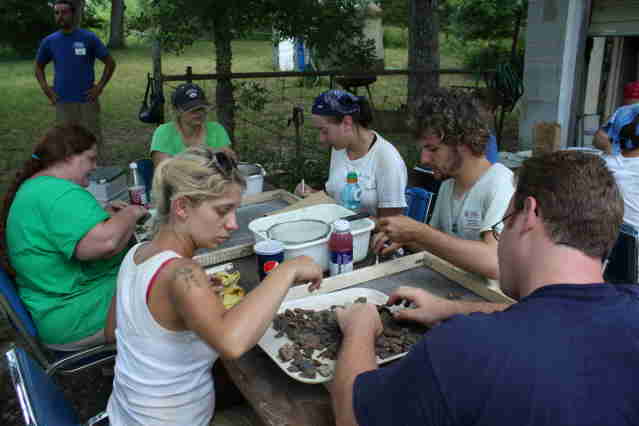
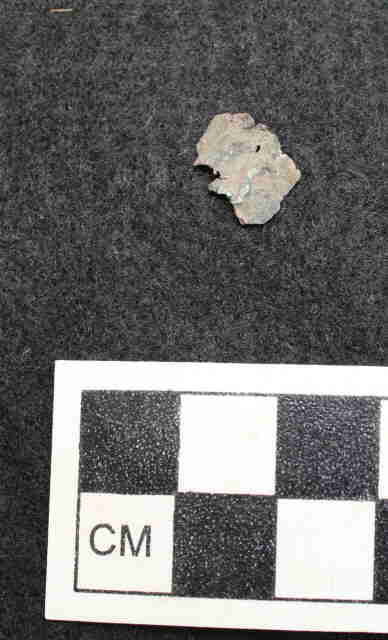



Another day in the high 90s with equally high humidity. We worked slowly with frequent water breaks in the morning -- although a single day like this is not too bad, the cumulative effects of several 90+ days in a row means we have to be particularly careful and cautious to avoid dehydration. The photo below shows the completed excavation of the wall trench from yesterday (Feature 144). We now have one corner of this building -- not enough to tell the full dimensions on the south and west, but enough to allow us to tell the orientation. The results of our larger scale GPR survey did faintly show a similar circular anomaly -- not very conclusive, but the fact that it shows up on both encouraged us to do a bit of "ground truthing" before we close up. Below are the results of the GPR survey -- with the mag survey results overlaid. The yellow rectangle outlines the area where we opened up three excavation units today. We hope to cross the edge of the circle -- and see what might be creating the reflection on the GPR and magnetometer. Below, three of our student crews begin to lay out excavation units and strip the sod across the field. By late morning, the sod had been stripped from these units in preparation for our last Volunteer Day tomorrow. In the early afternoon, we were pleased to host a visit from three distinguished southeastern archaeologists
-- James Knight (University of Alabama), John O'Hear (Cobb Institute of Archaeology, Mississippi state University), and Vin Steponaitis (University of North Carolina). We appreciate their thoughts and insights on Castalian Springs and our discoveries this season. [Left to right: John O'Hear, Jim Knight, Kevin Smith, and Vin Steponaitis]. Due to the weather, we broke early this afternoon -- giving the students and staff some much needed time to rest and rehydrate for our last few days.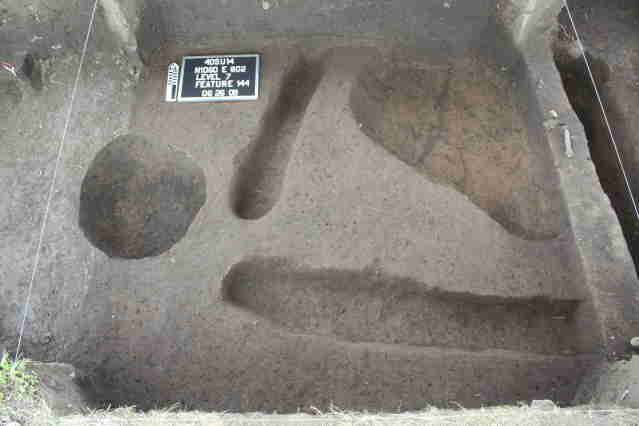
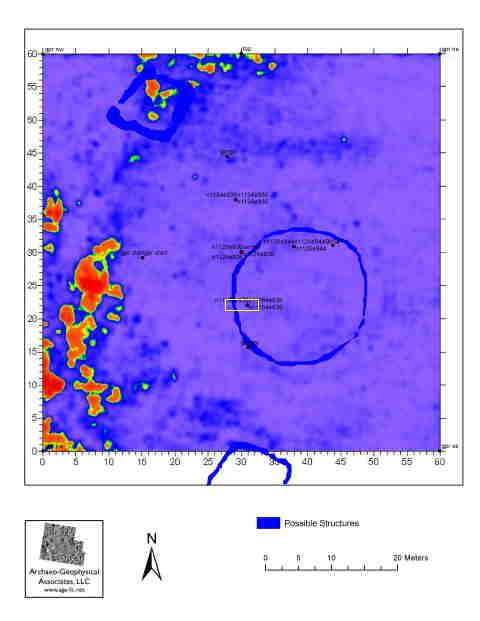

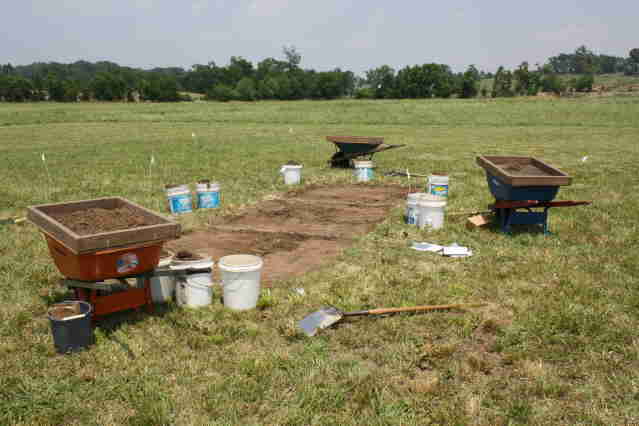

Today was the last of our scheduled Volunteer Days for Summer 2009. On Monday we will be starting to close up our project -- the last day is Thursday, July 2. Despite the oppressive heat and humidity early in the morning, we had 20 volunteers show up to work with about ten of our student crew members. Our thanks to several of our field school alums who showed up to help out -- Gwen Ayers (2006), Jennifer Clinton (2007), Georgia Dennis (1999), Ali Jordan (2007), Steaven Robbins (1999), and Jesse Tune (2006 and 2007). Several friends and family members also showed up -- A.C. and Barbara Graves (Brady's grandparents), Christina Hodgins (Brady's significant other), Jason, Hollie, Laylee and Forrest Lorigan (Kerri's family), and Cindy Russell (Ellen-Craig's mom). We had several returning volunteers -- Tom and Heather Carden, Mark Crawford, LeAnne Johnson, Judy Shook -- and a new volunteer, Claire Cobb. Out on our circular anomaly, Alethia and Kerri (at right) screen with Laylee and Hollie. Here, Claire and Gwen pick through some of the dry plowzone materials from over the circular anomaly. Back at our main excavation area, Jesse tries to figure out one of our larger wall trenches. As we try to clean up over the corner of one of our wall trenches -- Brady and Jason kept two screens of volunteers at work. In the background below, A.C., Barbara, Christina and Heather pick through the screen while in the foreground LeAnne and Tom work on another bucket of dirt.
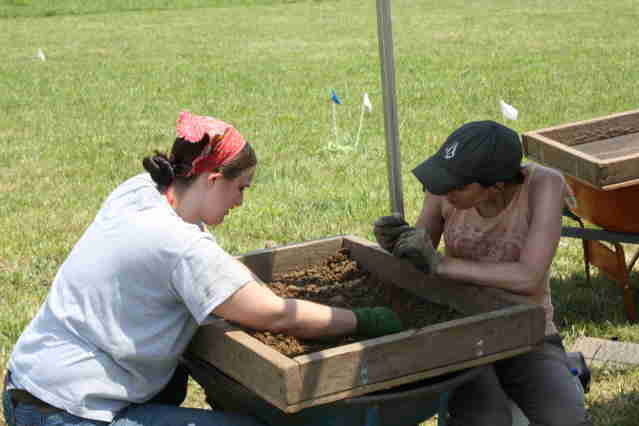
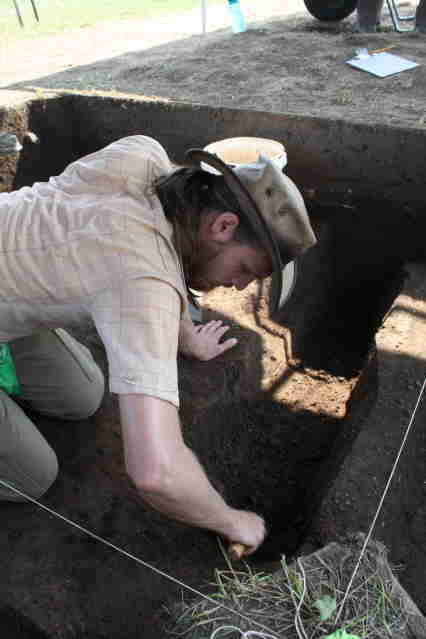
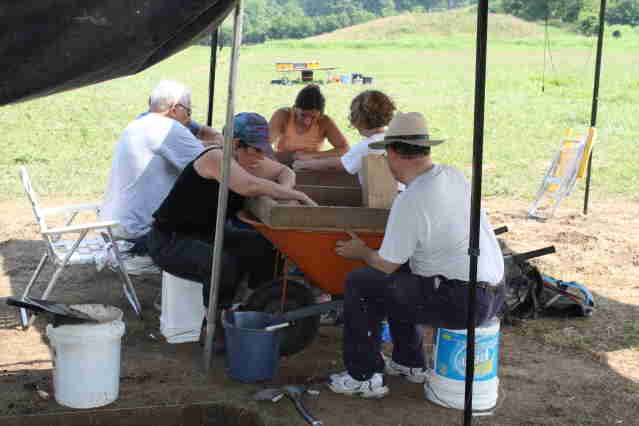
With the large number of students and volunteers, we did not have enough wheelbarrows for everyone. Here, Steaven and Judy make do with a screen and sawhorses over at the backdirt pile.
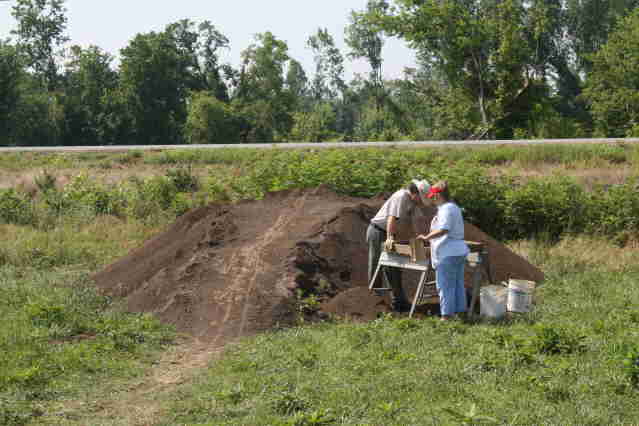
In the background, Jerome works to clean up and interpret the various dark stains in his unit while Steaven, Judy, and Georgia excavate and screen the midden overlying the large wall trench.
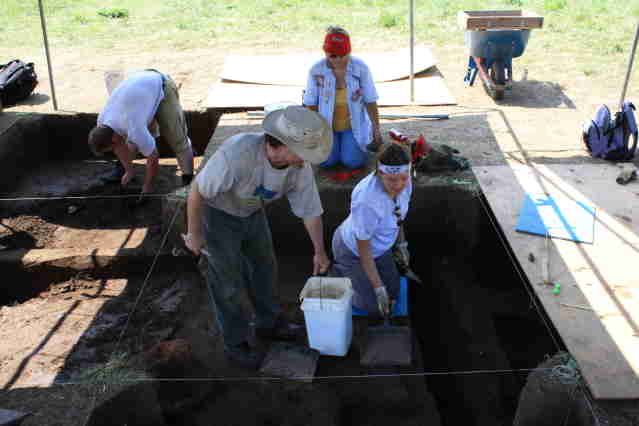
During the process, they discovered a very well preserved plastron section from a box turtle.

Before noon -- thanks to the volunteers -- we had finished cleaning up one of our new units. Below, is the formal photograph showing Feature 155 -- part of a large pit feature with clusters of limestone and pottery in it. Feature 136 is a continuation of the wall trench partially excavated at the top right. Feature 156 is what we had hoped to find in this unit -- the north wall of this trench. So, we have one corner of another of our structures.

The image below shows the two trenches outlined in yellow -- and the large pit outlined in blue. The pit appears to have been earlier than the house -- the trench for the west wall cut through the trash deposits.

With the temperature already already well over 90 and headed toward 100, we closed up our digs at noon. Next week, we will hope for a few days of mid 80s to finish out our project.
Our thanks for a really great day today. When I got up this morning, my thermometer read 60 degrees -- ten degrees cooler than last week. And even better -- the humidity was well below 50%. With only a couple of excavation days left, several of the students started very early this morning to make sure that we get finished up. Shortly after 6:00, Brady, Michael, Gage, Ellen-Craig, and Amanda were working with Erik to finish Level 1 on two of our units over the circular anomaly. Thanks to their early morning efforts, we were able to make some good progress across the field -- before focusing our efforts for the rest of the day on our main excavation area. Back in that area, we continued working on many of our wall trenches, pits, and postholes. During the course of that work, several interesting artifacts showed up. Below is the top of a very large hooded bottle with a topknot decoration. These vessels are bottle like forms with the opening on the side -- the "rim" of the opening is at the right below. We also recovered a nice rim portion of a jar with a handle -- probably dating from the style to around A.D. 1200-1250. Beneath the large pit that we have worked on for several weeks, we found what appeared to be the top of a posthole -- shown in the photo below as a dark stain with charcoal around the edges. As we investigated it, it turned out to be a small pit full of charred corncobs. All of the black material below consists of fragments of corn cobs -- burned over 900 years ago by native inhabitants of this town. Later in the day, Dr. Shannon Hodge -- our project bioarchaeologist -- dropped by for a visit with Caroline and John. John brought his dump truck and front-end loader to help us with backfilling. Dr. Hodge also brought a nice cooler fulls of sodas and water -- our thanks! John also spent some time discussing his interpretation of our finds with the students -- here, he is giving Tiffany S. some insights into life, the universe, and everything. By the end of the day -- thanks to the dedicated labors of our entire crew -- we had cleaned up our main excavation area for some high altitude photos to show what we've found this year. The photo below shows the multitude of structures, pits, postholes, and other features we've discovered this year. The image below (same as above) shows our interpretations of what we've found so far. One of our wall trench structures is highlighted in yellow at left -- we only have one corner, so we don't know how big it was. At center, another of our wall trench structures is highlighted in blue -- our interpretations from previous days have changed as we actually excavated the features. Our third probable wall trench structure is highlighted in white -- it appears that most of the south trench for this structure (the trench at left in the photo) was destroyed by later construction of the blue building and a pit. The small and large pits that we have found are outlined in red. The postholes that we have found are outlined in green. While it will take us another few weeks to digest what we've found this summer and figure it all out, it seems that our efforts have been rewarded. We have found a very important part of this ancient Sumner County community -- a little bit of a neighborhood of houses and buildings. Tomorrow, we will finish up our digs in this area, complete our paperwork, and shift most of our crew across the field for one day over the circular anomaly. While we won't be able to complete excavations there -- we should at least be able to expose the top of whatever is there. On Wednesday morning, we will start the bittersweet task of putting the dirt back into all of our excavations. By then we will have recorded, documented and photographed everything -- and we will restore our excavations as close as possible to how they looked when we arrived. The weather promises to be good the next few days. And, as they say -- to all a good night!

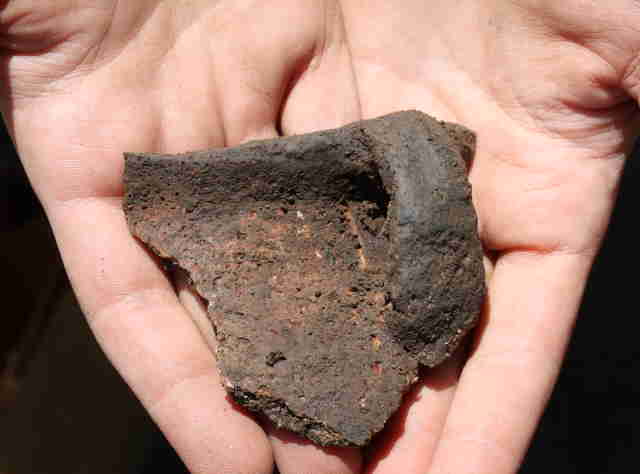
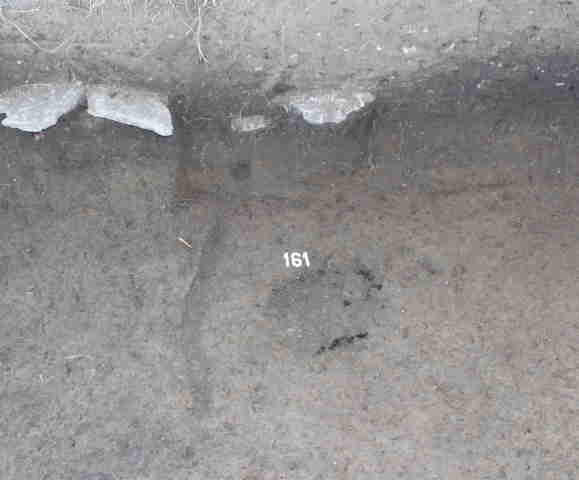

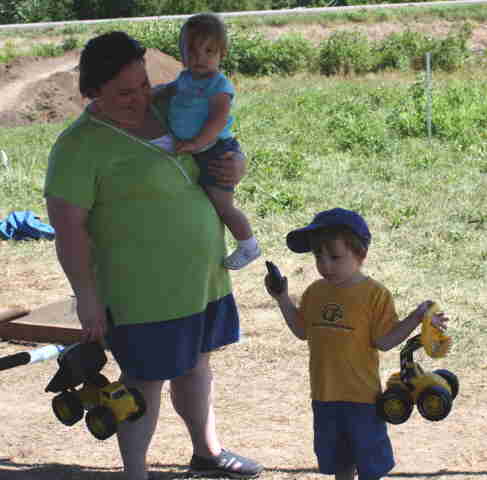
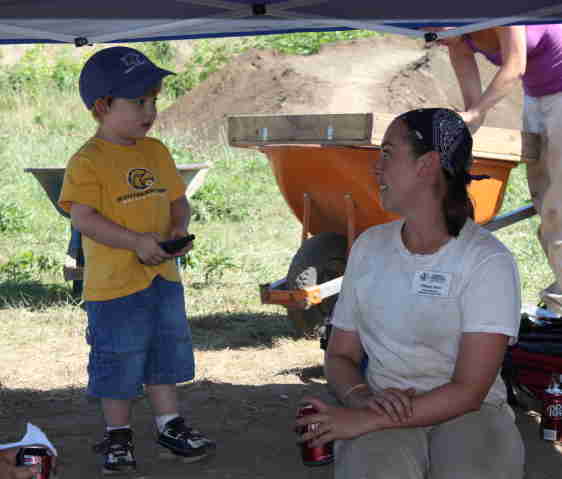


Another beautiful day today -- low humidity, not too hot, and a nice breeze. Since we are running out of time to finish our work, over half of the crew showed up at 7:00 this morning to gain us a few extra hours. Thanks to the hard work of the crew all day long, we were able to finish up almost all of our excavation and recording in our main area. The photo below shows the corner of the south wall trench house after excavation. Here, Michael points at one of the small postmolds in the trench of the south structure. We also completed excavations on the north wall-trench structure -- two corners are visible in the photograph below. The hearth or fireplace discovered earlier now appears to be in the center of this structure (in the photo, at the far upper left). Although we had some doubts that the "hearth" was actually a fireplace for a structure, we cross-sectioned it today (basically cut it in half) to get a better idea of what it looked like. Looking at the profile (shown below), it seems much more clearly a fireplace. The edited image below shows two construction stages of the fireplace. The yellow fireplace is the earliest -- it was then refurbished or rebuilt at least once (shown in white). Most of the rest of our work today was completing drawings of the features and soil profiles of the units. Below, Erik, Gage, Alethia, Kerri, and Ellen-Craig document wall trenches, hearths, and profiles. Far across the field on the east side, two of our crews made excellent progress on examining the circular anomaly. Exactly where the magnetomer and ground-penetrating radar indicated, we uncovered a major change in the soil. The photo below shows the soil change highlighted -- in yellow may represent the remnants of an earth embankment around a building. Although only a small portion was exposed today, the white outlines what may be part of a circular wall trench. We will have a few more hours tomorrow to expose a bit more of these features. As the day proceeds tomorrow, we will start the task of backfilling our excavation areas in preparation for the final closeup on Thursday.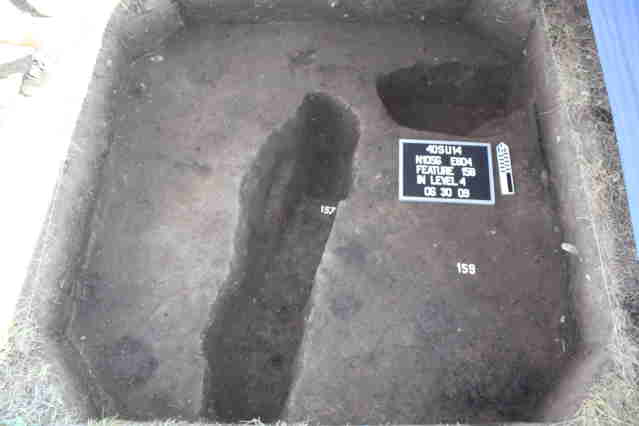

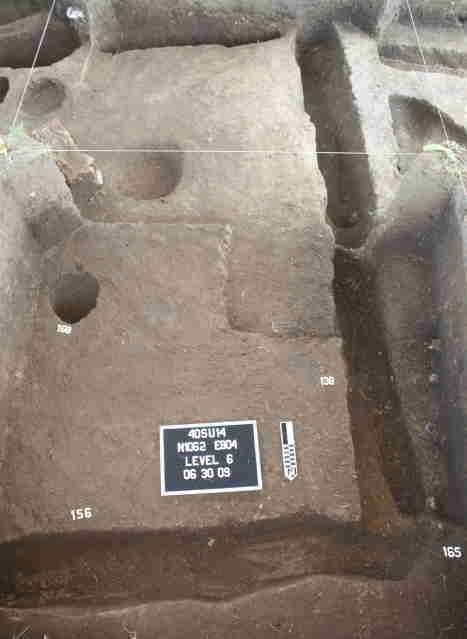
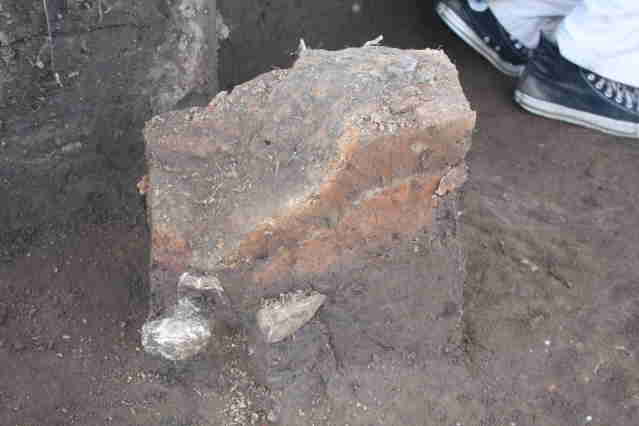
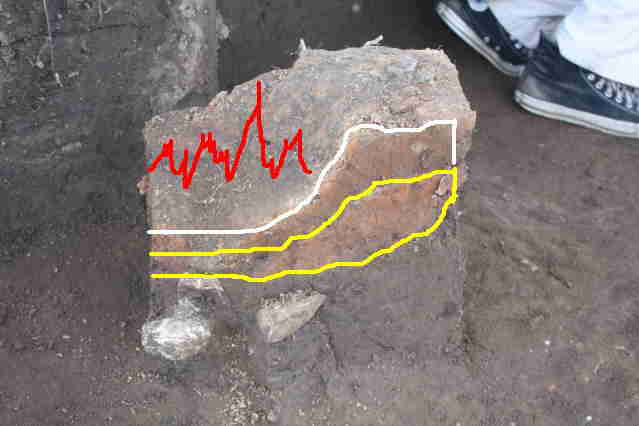
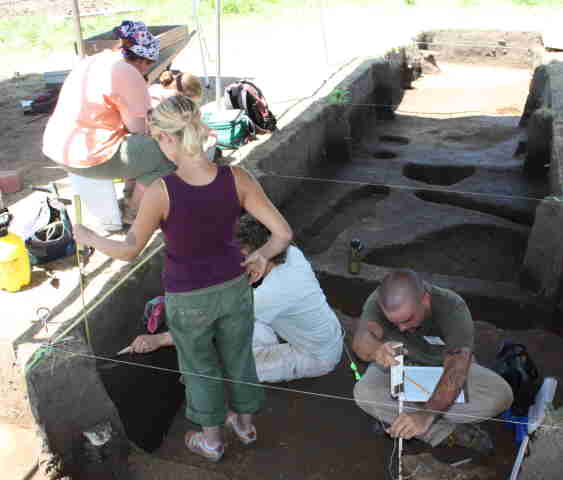
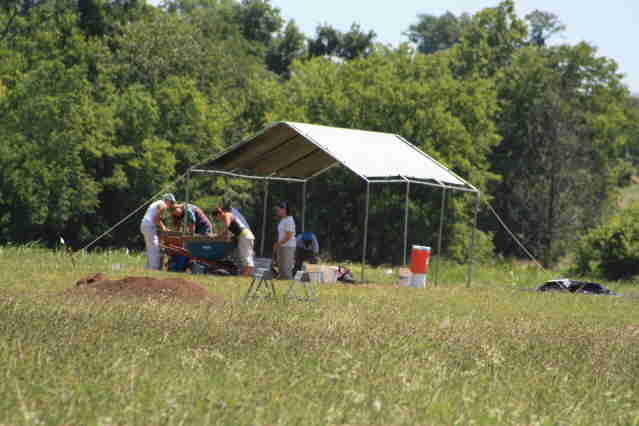

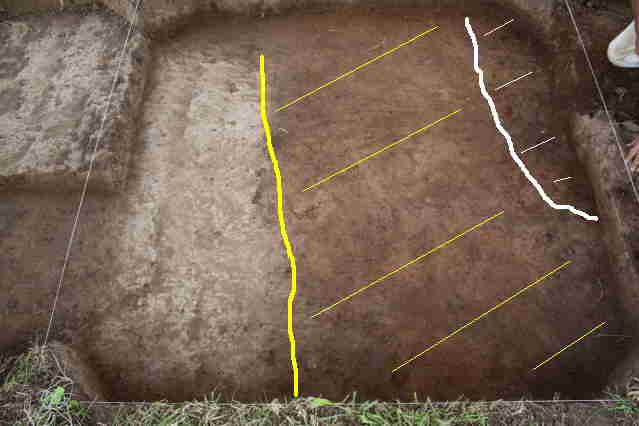
As we near the end of our Summer 2009 project, the weather has definitely taken a turn for the better. Most of the crew showed up well before 8:00 am this morning to make sure that we are at a closing point by tomorrow afternoon. During the morning we completed excavating all of the features in our main dig area and cleaned everything up for a final set of photographs. We have accomplished a great deal in five short weeks -- particularly given the hours missed to storms and to extreme heat. During those weeks, we have investigated parts of three residences or workshops occupied around A.D 1200. Two of the structures (outlined in yellow and white below) may have been occupied at the same time. They are oriented similarly and well spaced to be part of a cluster of houses. The blue structure appears to have been constructed at some later date -- it obliterated part of the white structure's southern wall trench. The walls of the blue structure are also oriented differently from the other two. Over on the east side, we did not have enough time to do much more than simply expose the top of our circular anomaly. After stripping the plowzone, a series of stunningly distinct colored soils was uncovered. While further excavation will be needed, these distinctions certainly suggest that the circular anomaly is not simply geological. We will turn our full attention to this area when we return next summer. We gathered briefly on the backdirt pile for the 2009 crew photo. The remainder of the day was spent in backfilling our excavation areas -- and restoring them as closely as possible to their original appearance. The mountain quickly diminished in size. Tomorrow, the field portion of the project will close down -- and our efforts will shift to the lab for the next several months.

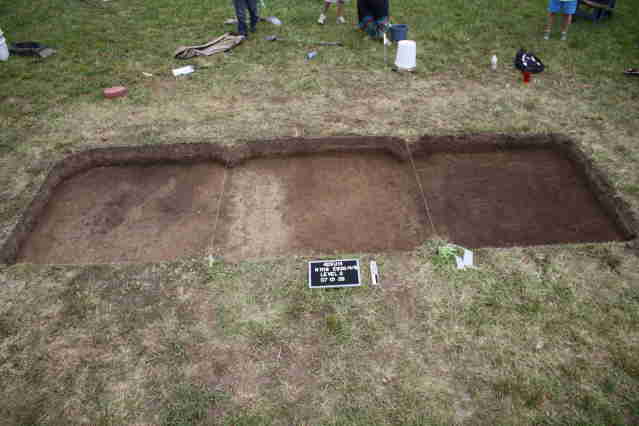
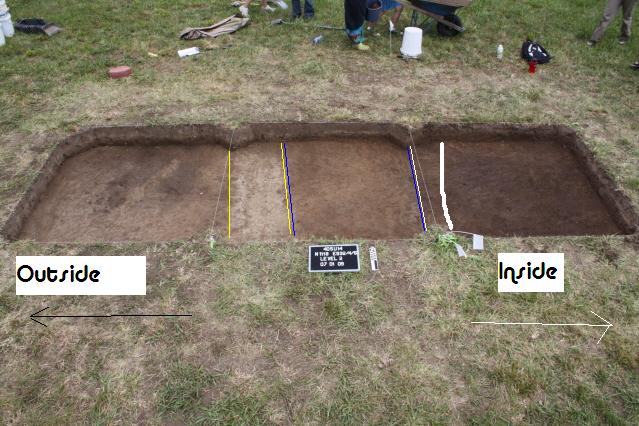
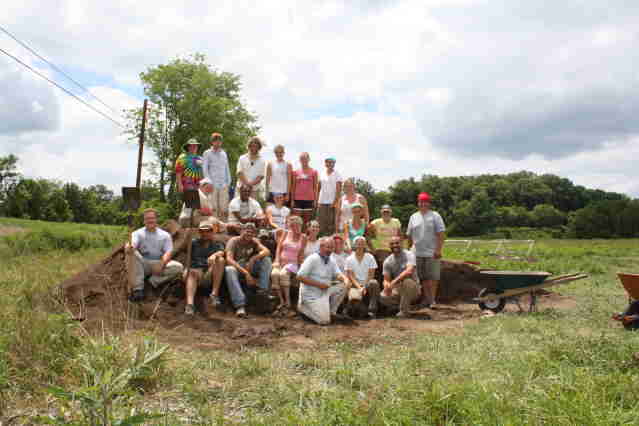
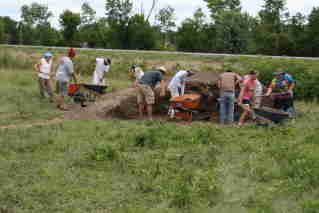
Beginning around 7:00 am, we completed our backfilling of units across the site. By mid-morning, we had reduced our backdirt pile to nothing, filled our units, and put the sod back on top. We then worked to clean, package, and load our equipment for storage until next summer. After a cookout for lunch, the crew went their separate ways. For now, we close off our story of discovery at Castalian Springs.
